
5 Process Essay Examples
A process essay is a type of essay that explains a process in detail. Good process essays don’t just explain the process but provides details about common mistakes to avoid as well as tips and methods to achieve success. Below are some example essays:
Process Essay Examples
#1 how to bake a chocolate cake.
1337 Words | 4 Pages

Thesis Statement: “The purpose of this essay is to guide readers through the enjoyable and straightforward process of baking a chocolate cake, highlighting the essential steps and tips to ensure a delicious and successful outcome.”
#2 How to Write a Resume

Thesis Statement: “This essay aims to provide a comprehensive guide on crafting an effective resume, detailing each step from gathering relevant information to finalizing the document, while offering practical tips and common pitfalls to avoid, ensuring a polished and professional presentation of one’s career achievements and qualifications.”
#3 How to Train for a Marathon
1508 Words | 5 Pages

Thesis Statement: “This essay provides a comprehensive guide to marathon training, detailing a strategic approach to building endurance, strength, and speed, coupled with essential advice on nutrition, hydration, and mental preparation, to equip runners of all levels with the knowledge and tools necessary for successfully completing a marathon.”
#4 How to Prepare for a Job Interview
1309 Words | 5 Pages

Thesis Statement: “This essay outlines a comprehensive strategy for job interview preparation, encompassing in-depth company research, personalized response formulation, professional presentation, and logistical planning, to equip candidates with the tools necessary for making a compelling and confident impression in their pursuit of career opportunities.”
#5 How to Write an Essay
1473 Words | 5 Pages

Thesis Statement: “This essay outlines a comprehensive, step-by-step approach to essay writing, from understanding the prompt to the final stages of revision and editing, providing essential tips and strategies to enhance writing skills and ensure the creation of a well-structured, persuasive, and effectively communicated piece.”
How to Write a Process Essay
The following template provides an overview of a process essay structure:

Grab this process essay template here.
Instructions: To write a process essay, start by introducing the process and its significance, ensuring the reader understands the purpose and value of the instructions. Next, present the preparation and materials required, before outlining each step of the process in a logical order, offering detailed explanations, tips, and potential pitfalls to avoid, ensuring clarity and ease of understanding. Conclude by summarizing the main steps and reinforcing the benefits or results of completing the process, leaving the reader with a clear understanding and the confidence to undertake the task.
How to Write a Thesis Statement for a Process
To write a thesis statement for a process essay, identify the process you’re explaining and clearly state the purpose or goal of the essay. Concisely outline the primary steps or stages involved in the process, ensuring clarity and direction for the reader. The thesis should be informative, indicating what the reader can expect to learn and achieve by following the essay.
💡 AI Prompt For Writing a Process Essay Thesis Statement “Create a thesis statement for a process essay on [TOPIC] that clearly identifies the specific process being explained. The thesis should state the purpose of the essay and briefly outline the main steps or stages involved in the process. Ensure that the statement is concise, informative, and guides the reader on what they will learn and achieve by reading the essay.”
Read Also: 101 Thesis Statement Examples
Suggested Process Essay Topics
For Grades 4 to 8:
- How to Organize a School Backpack.
- Steps to Create a Simple Science Fair Project.
- The Process of Planting and Caring for a Vegetable Garden.
- How to Write a Book Report.
- Making a Handcrafted Greeting Card.
For Grades 9 to 12:
- How to Prepare for the SATs.
- Steps for Conducting a Basic Scientific Experiment.
- Crafting an Effective Persuasive Essay.
- Planning and Executing a Community Service Project.
- The Process of Creating a Personal Budget.
For University/College:
- How to Conduct a Literature Review for a Research Paper.
- Writing a Successful College Application Essay.
- The Process of Developing a Mobile App.
- How to Create a Comprehensive Marketing Plan.
- Steps for Conducting a Qualitative Research Study.
- Preparing and Delivering an Effective Oral Presentation.
- The Process of Writing a Business Plan.
- How to Analyze a Case Study in Business School.
- Crafting a Dissertation or Thesis Proposal.
- Developing and Implementing a Personal Fitness Plan.
Ready to Write your Essay?

Take action! Choose one of the following options to start writing your essay now:

Chris Drew (PhD)
Dr. Chris Drew is the founder of the Helpful Professor. He holds a PhD in education and has published over 20 articles in scholarly journals. He is the former editor of the Journal of Learning Development in Higher Education. [Image Descriptor: Photo of Chris]
- Chris Drew (PhD) https://helpfulprofessor.com/author/chris-drew-phd/ 5 Top Tips for Succeeding at University
- Chris Drew (PhD) https://helpfulprofessor.com/author/chris-drew-phd/ 50 Durable Goods Examples
- Chris Drew (PhD) https://helpfulprofessor.com/author/chris-drew-phd/ 100 Consumer Goods Examples
- Chris Drew (PhD) https://helpfulprofessor.com/author/chris-drew-phd/ 30 Globalization Pros and Cons
Leave a Comment Cancel Reply
Your email address will not be published. Required fields are marked *
How to Write a Process Essay

The process essay, also known as the "how-to" essay, is commonly written for people or companies that need tutorials or a set of instructional steps. Whether it's building a robot or cooking a chocolate cake, process essays use a similar format for any variations. They follow a step-by-step style, with the initial step influencing the second, which influences the third, and so on. Each step carries its own importance, and a poor explanation of one step can ruin the entire process. It's important to stay concise and efficient. However, before you begin writing your essay, you should do some small preparations. Let's discover them with our research writing service .
What Is a Process Paper?
A process essay is a type of essay that explains a process step by step and gives guidance for a certain process, working mechanism, procedure, etc. Process essays range from very simple ones, such as instructions for how to ride a bicycle, to more complex ones, such as a chemistry lab report of an oxidative reaction experiment. The goal of a process paper is to give its readers guidance and directions.
Feeling Overwhelmed Writing a Process Essay on Your Own?
Simply send us your paper requirements, choose your paper writer and we’ll get it done fast.
A process paper is characterized, first of all, by explaining a process using a description. Some words that are frequently used in process essays are “further”, “then”, “next”, “first”, “last”, “finally”, and “initially”. It is really important to remember that every process essay includes features, such as:
- clear and straightforward narration - the last thing you want to do is to confuse your reader with complex language and an unorganized thought thread;
- chronological order - avoid skipping steps and shifting them around, as it will result in misunderstanding and frustration for the readers;
- transition words - make sure to separate the next step from the previous ones by using transition words;
- descriptions of the steps - make sure your steps are clear and easy to follow.
There are several types of process essays. The first one is directional - it explains the “how to” for something. It can take on a wide range of subjects, such as how to apply for a credit card, how to get your driver’s license, how to plan a wedding, etc. The outcome of the directional essay should be a result. In the cases of the examples above: a credit card, a driver’s license, or a carefully planned wedding. The other type of process paper is informational - it explains how something works. Here are some examples: how a weather forecast is determined, how a space rocket works, how intermittent fasting changes your body, etc. An informational essay explains something to a reader and does not necessarily end up with a result, like directional does.
Another type of essay that is similar to a process essay is a process analysis essay. The biggest difference is that a process analysis essay not only explains the steps, but also analyses them in depth. It has all of the characteristics of a process essay, although goes into more detail about the causes and consequences of every step.
If you need any additional information for process analysis essays, check out our article: HOW TO WRITE A PROCESS ANALYSIS ESSAY
Writing a process essay is not extremely difficult. By following simple rules and a set of steps, a successful, well-structured essay can be guaranteed.
Prepare The Small Stuff
Here we gathered some small general tips and advice that you should follow throughout your writing process to make sure that all of the expectations of a process paper are met.
- Determine the Audience's Skill Level. It's important to base the level of complexity of the essay on who the readers will be. For example, if you need to teach a friend how to do a simple fix or create a certain tool, then it would be most reasonable to stick to more basic terminology. However, if you are writing an essay for your astrophysics professor about the creation of a black hole in the universe, use more sophisticated and informative terminology.
- Make a List of Materials. Obviously, the creation of anything comes with some prerequisites. Whether it's items or ideas, the importance of knowing the necessities beforehand and having them ready to go is essential. Make sure to place each item in accordance with its importance. The more impactful a part is, the higher up on the list it should be.
- Write out Each Task. In a step-by-step tutorial, each individual task carries some sort of weight. Since an entire process can not be complete if a step is skipped, it's crucial to write out every single step. However, don't go overboard in your explanations. It's not necessary to bring the tutorial to a microscopic level, but each step should be understandable and competent.
If you still have difficulty writing, you can get essay help online from our service.
Process Essay Topics
Choosing a topic for a process paper can be quite challenging. A good place to start is with your passions. If you pick something you are excited about, you can make it interesting for your readers and fun for yourself to write about. If your professor limits you to write a process essay on something you have very little knowledge of, choose a topic that is intriguing and triggers your interest. Then, conduct enough thorough research to make sure you understand everything perfectly before you go ahead and try to explain it to someone else.

Another very important thing to consider while writing a process essay is your audience. It is highly unlikely that college students are interested in instructions for “How to Get Into Your Dream School” or “How to Pass Your SATs”. Make sure your topic relates to the subject you are studying and you are following your professor’s prompt guidelines.
Here are some ideas that might be of interest for you:
- How to lose weight on a keto diet
- How your immune system fights COVID-19
- How to start selling on Amazon
- How to improve your credit score
- How to decrease your social media usage
- How to apply for unemployment insurance
- How to improve your college performance
- How to open your first bank account
It's important to note that these essay topics are just some common examples used by several college students for their course papers. Feel free to use any one of them if you want, or think of one on your own. Just make sure it's a PROCESS!
Process Essay Outline
Most essay outlines follow the standard scheme: Intro > Body Paragraphs > Conclusion . follow the standard scheme: Intro > Body Paragraphs > Conclusion. A good process essay outline should look like this:
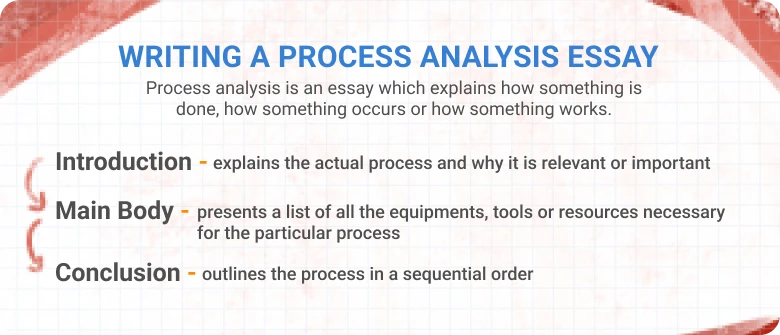
- Introduction — brief your reader on your topic, explain why you have chosen it and how you are planning to approach the explanation of the process.
- Body — the biggest part of your essay that should be divided into paragraphs for easier understanding and structure. Make sure each paragraph is flowing smoothly into the next one with connective words.
Paragraph 1. First step of the process. Explain what the step is, what the best way to perform it is, and how to avoid common mistakes when doing it.
Paragraph 2. The next step of the process (the same as in Paragraph 1). Thoroughly explain what this step is about.
- Conclusion . Here you need to explain why your instructions are valuable. It is your opportunity to persuade your reader(s) that the steps you presented and the process they learned will be useful for them in the future.
Every process is different: some can take a couple of minutes, while others can take months or years to complete. The length of the essay is generally based on the difficulty and number of steps it takes. However, the structure doesn't maneuver.
Introduction
The first thing that you want to do as a writer for your process paper is to help your readers be interested in your individual process. Be descriptive about it, paint a picture for your readers. A joke or a personal reference can be a great attention grabber and can pull your reader right in. For somebody to be keen on approaching your process, they have to express interest in it. Though, it generally goes without saying that many writers ignore this fact. Let's break it down into subsections:
- Give a little bit of historical background. People often want to know the origins of whatever it is that they're working on. Introducing this part of the process helps to intrigue your readers, as well as give them a sense of purpose for the task.
- Create an approximate timeframe. Unfortunately, your readers don't have all day to spend on this one event. In addition to learning about its purpose, people want to know how long the task will take. This way, they can decide how to break up the work. If it's a quick fix, then they can knock it out in one session. However, if it's a large-scale operation, then your readers will obviously have to create their own time schedule.
For example, let’s say that the topic of your essay is “How to Save Money”. You can start the introduction of your process essay by explaining that as a college student, you often find yourself in need of extra money and you are stuck with bad money habits. This will create a good connection with your readers, because almost everyone has been in a situation of needing to be savvy with their finances. Another thing you can mention is the importance of saving money and the multiple opportunities it presents, such as being able to invest it, being able to pay off a credit card debt, or being able to save up to avoid taking out a student loan.
Feeling Overloaded and Stressed?
Our professional writers are ready to help you 24/7!
Body Paragraphs
This is the point in the process essay where you start introducing the step-by-step process your readers will need to take. A lot of the time, it helps to break down each process into subsections. For example, if a step has many parts to it, it would be clever to create a paragraph on its own just for that step. Remember, it's important to keep things smooth and efficient. Break down the body paragraphs in unity with the steps. Let's go into more detail about each step:
Each step should be carefully explained. Every step will vary in length. Think about it: every instruction manual has several steps. Some are more difficult to comprehend or perform than others. For this reason, create your steps and explanations accordingly. You should be able to get a sense of their length and difficulty based on the explanation.
Don't forget to explain the purpose. People don't want orders barked at them aimlessly. Besides just accomplishing a task, people want to learn as they perform.
- Why did they do this?
- What was the purpose of this method?
- Why did we do it this way and not this other way?
To make everything flow smoothly use transitions. Make the steps flow one after another to create a well-structured essay. As you introduce the next step, consider using transition words like “next”, “now”, “then”, “so that”, etc.
Before writing the steps out in full sentences, it is a great idea to create an outline for your body paragraphs. Here is an outline for the body paragraphs of a process essay on “How to Save Money”:
Paragraph 1:
- keep track of your expenses
- organize your collected data
- decide what you can skimp on in your spendings
Paragraph 2:
- create a realistic budget
- check weekly to ensure you are sticking to it
- save 15% of every monthly income
- set a tangible goal for saving, such as a car
These process essay examples use only two body paragraphs, but feel free to include more to ensure a better understanding and cohesive flow for your paper. Although, do not include excessive unnecessary details that clutter your essay and make understanding it even more difficult. While writing your essay, include small brief explanations for each statement. For example, “Even though eating out and grabbing a coffee on your way to class sounds tempting, setting a budget and saving 15% of each of your monthly earnings aside can help you have enough to put down a downpayment on a new car.” Here the reader will understand that there is a direct relationship between each step and the result it is going to give.
Showing the readers that they are learning and not just repeating is one of the most effective ways to lock down their attention and keep them coming back!
After going through every step meticulously and explaining the whole process, a process essay needs a confident conclusion. This paragraph should be short, sweet, and to the point. It's main goal is to accomplish the following tasks:
- Discuss the main result. After the readers have completed the process, they should be left with a final result. It's important that you explain to your readers what the end result will look like, and what can be done with it.
- Restate the process’s general purpose. After completing the task, you obviously would like to know its overall purpose. When your readers feel that they have accomplished a challenge, learned something from it, and have a path to take the result towards, they will be satisfied!
- State your Overall Conclusion. To put a pretty tie around your process essay means that you need to neatly wrap things up! Restate some of the highlightable points as well as the process’s key overall purpose. Make sure that your readers feel accomplished after going through your process, and ensure that you strengthen the necessity of its purpose with a nice concluding sentence!
The conclusion of an essay on “How to Save Money” would explain that the completion of all of the steps will result in saving money that can be used for a specific goal or for rainy day fund purposes. You can mention the importance of every step and briefly repeat some of the key points.
Post-Writing Tips
Here are some final tips to wrap up your writing process. Use them as a checklist for a successful and coherent essay.
- Make sure the work is simple enough to follow. Worst-case-scenario: its author creates a feeling of absolute confusion in the reader’s mind. To avoid this problem, always remember that your readers can be beginners. Do not try to impress them with complicated words or sentences, use simple language to provide clear directions on how to do something. Give as many details as possible, but do it plainly. "Why is he making me do this?" "What was the purpose of this?" "I don't understand this step at all!" If the reader is asking themself these questions, then it's time to do some editing!
- Experiment and try it for yourself or ask a friend. There's no better way to experience success than to actively attempt your process through your own instructions. If everything truly makes sense, then you should have no problem solving the task using your own words. Even better, ask a peer to try it through your words to get an outside point of view.
- Choose the right topic for you and research it well
- Maintain a logical order of steps, make it easy to follow
- Avoid using imperative sentences - you do not want to sound like an Apple TV manual
- Explain terms that are most likely outside of most people’s range of common knowledge
If you have a ready-made essay but need to make significant changes to it, you can use our rewrite my essay service .
Process Essay Examples
Now that you know all about process essays and how to write them, we have prepared some great essay topic ideas in case you are stuck and cannot choose one:
Building a business from scratch is an intricate process that entails a number of steps. Each of these steps should have specific objectives and measurable outcomes.The following analysis gives the basic steps followed when building any business from scratch.
Saving can be defined as a differed consumption or keeping aside a portion of your income for unexpected future uncertainties or plans. Read for reason and actual steps for saving more money
Read also a thesis statement example from our author. In this article, you can learn something useful for yourself.
Still Need Help?
If you still feel like you could use some help with your process essay, do not hesitate to seek help from our writing service. Our writers specialize in a wide range of essays of different types including creative writing essay , process essays, and would be more than happy to assist you with writing, editing, or direction if you are feeling uneasy. Click the button below and college admission essay writer will process your requests fast.
Related Articles
.webp)
How to write a process essay
- August 25, 2023
Process essays are one of the most common types of essays . It’s simply explaining a process of how to do something.
In this article, we’ll show you how to write a process essay in steps with interactive examples.
Process essay definition
Let’s take a look at the steps outlined below to write a clear and effective process essay.
Choose a topic
You should start by choosing a topic that not only interests you but also attracts your target audience.
Whether it’s brewing the perfect cup of coffee or conquering the art of origami, your topic should be engaging and well-defined. Let’s have a look at topic examples:
- Crafting Exquisite Miniature Bookbindings
- Building a Sustainable Vertical Garden
- Making the Perfect Cup of Coffee
So for this guide, I’ve chosen “Making the Perfect Cup of Coffee”. Now let’s continue with the next steps.
Create a process essay outline
Now that you’ve your topic at hand, it’s time to create an outline to present the steps chronologically. Outline will also help you organize your thoughts and ideas so you won’t get lost during the writing process.
Let’s examine this step with an example of a process essay explaining “Making the Perfect Cup of Coffee”.
Process essay outline example
- Thesis statement
- Provide safety precautions if necessary.
- Address to the reader
- Provide any variations or customization options if applicable.
- End with a memorable concluding thought or call to action.
By presenting the steps in chronological order, your readers can follow the process smoothly.
During this step, just make sure to:
- Expand on each step you outlined earlier.
- Use clear and concise language.
- Make use of bullet points or numbered lists to make the process visually appealing.
After completing the outline, it’s time to write an interesting introduction.
Write an introduction
- Hook the reader's interest with a hook sentence
- Offer a brief overview of the topic and its significance
- Introduce and explain the process with a thesis statement at the end of introduction
Process essay introduction example
Introduction
Now that we have an intro on our hand, you need to tell what materials you need to finish the process.
Write the materials needed for the process
Listing the necessary materials for the process is a best practice for process essays. Typically found just after the introduction, this paragraph is devoted to outlining the necessary materials.
Here, p rioritizing the list is important; the more influential a component is, the higher its position on the list should be.
Example material list for process essay
Body paragraphs
Materials needed
- High-quality coffee beans that align with your flavor preference.
- A grinder for optimal flavor extraction.
- Equipment for brewing methods, such as a pour-over apparatus, a drip coffee maker, a French press, or an espresso machine.
- Fresh and clean water for brewing.
- Optional additives like milk, cream, sugar, flavored syrups, or other preferred elements.
Start writing the process
Right after listing the materials needed, it’s time to start writing the process itself.
When describing your process, be careful not to make it too complicated. To keep your readers on track, use transitional words like “after,” “eventually,” “first,” “then,” and others help you maintain an understandable tone.
Or simply use a 1,2,3, bullet point structure as seen in example below to remind readers of their step during the process.
Body paragraphs - Process writing example
Materials needed ...
- Grind the beans just before brewing for optimal freshness. Use a burr grinder and adjust the coarseness to match your brewing method (coarse for French press, fine for espresso).
- Weigh your coffee grounds using a scale. A standard ratio is 1 to 2 tablespoons of coffee per 6 ounces of water, but adjust to your taste.
- Ensure the water is heated to the ideal temperature, typically between 195-205°F (90-96°C). Water that's too hot or too cold can affect the taste.
- Pay attention to the brewing time. Generally, 4-5 minutes is suitable for most methods, but again, adjust based on your preference.
- After finishing, regularly clean your coffee maker or French press to prevent rancid oils and residue from affecting your coffee's taste.
As seen from the example above, using an imperative language structure is generally preferable. It makes total sense as you’re describing a process in steps and usually don’t need a full sentence structure.
Give tips and supporting details
After explaining the process above, it’s now time to provide tips and supporting details. Here, make use examples, tips, and even warnings if necessary.
In other words, anticipate the questions your readers might have and address them as you go along.
Body paragraphs - Supporting details
Supporting details & tips
- Ensure safe handling of hot water and coffee-making equipment.
- Water that's too hot can result in over-extraction, while water that's too cold won't extract enough flavor.
Write a conclusion
At this step, you simply need to write a conclusion paragraph to end your process essay. First summarize the key points, and restate the process in a concise and short sentence. And finally, finish your process essay by a memorable sentence or a call-to-action.
Process essay conclusion example
Revise and polish your essay.
Now that you’ve written your essay, take a breath, and then come back for some editing. Check for consistency, correct sentence structure, efficient transitions , tense selection , and other linguistic issues that may arise.
If possible, make use of proofreading tools like QuillBot or Grammarly .
- Think about potential reader misunderstandings and address them. If needed, explain what should be avoided.
- Offer explanations for steps that might seem unusual or complicated.
- Define any unfamiliar terms or materials that the reader might not understand. This ensures clarity in your essay.
So you’ve successfully learned how to write a captivating process essay. Remember, practice makes perfect. The more you write, the better you’ll become.
Recently on Tamara Blog
How to write a discussion essay (with steps & examples), writing a great poetry essay (steps & examples), how to write a process essay (steps & examples), writing a common app essay (steps & examples), how to write a synthesis essay (steps & examples), how to write a horror story.
How to Write a Great Process Essay
Otherwise Known as a How-To Essay
CSA-Archive / iStock Vectors / Getty Images
- Writing Essays
- Writing Research Papers
- English Grammar
- M.Ed., Education Administration, University of Georgia
- B.A., History, Armstrong State University
How-to essays , also known as process essays, are much like recipes: They provide instruction for carrying out a procedure or task. You can write a how-to essay about any procedure that you find interesting as long as your topic fits the teacher's assignment.
Start by Brainstorming
The first step in writing your how-to essay is brainstorming. Here are tips to help you:
- Draw a line down the middle of a sheet of paper to make two columns. Label one column "materials" and the other column "steps."
- Write down every item and every step you can think of that will be needed to carry out your task. Don't worry about trying to keep things in order yet. Just empty your head.
- Number your steps on your brainstorming page. Just jot a number beside each item/step. You may need to erase and scribble a few times to get the order right. It's not a neat process.
Create an Outline
First, determine the format required for your essay; ask your teacher if you are unsure. Your essay could contain a numbered list (like the one in the previous section), or it could be written as a standard narrative essay. If you are instructed to write a step-by-step without using numbers, your essay should contain all the elements of any other essay assignment, including an:
- Introductory paragraph : the section that identifies the topic , arouses interest, and prepares the audience or readers for the development of the thesis
- Body : the part of an essay that develops the main idea
- Conclusion : the sentences or paragraphs that bring the essay to a logical end
Regardless of the essay format—whether your teacher allows for numbered paragraphs or sections or simply wants you to craft a narrative report—your outline should center on these three areas.
Creating the Essay
Your introduction will explain why your topic is important or relevant. For example, your paper about "How to Wash a Dog" would explain that dog hygiene is important for your pet's good health.
- Your first body paragraph should contain a list of necessary materials. For example: "The equipment you will need depends somewhat on the size of your dog. At the very minimum, you will need dog shampoo, a large towel, and a container large enough to hold your dog. And, of course, you will need a dog."
- The next paragraphs should contain instructions for following steps in your process, as enumerated in your outline.
- Your summary, or conclusion, explains how your task or process should turn out if it is done correctly. It may also be appropriate to restate the importance of your topic.
Topics to Write About
You may believe that you are not expert enough to write a process essay. This is not so. There are many processes that you go through every day that you can write about, including:
- How to make a perfect paper airplane
- How to dye your hair
- How to wear makeup
- How to survive a weekend with your family
- How to play basketball
- How to play (a popular video game)
The goal in this type of assignment is to show that you can write a well-organized essay and clearly explain to the reader how to do what you are instructing.
- 6 Steps to Writing the Perfect Personal Essay
- How to Write and Format an MBA Essay
- How To Write an Essay
- List of Topics for How-to Essays
- Write an Attention-Grabbing Opening Sentence for an Essay
- How to Write a Response Paper
- How to Write a Narrative Essay or Speech
- What Is Expository Writing?
- How to Write a Great Essay for the TOEFL or TOEIC
- Tips on How to Write an Argumentative Essay
- How to Structure an Essay
- The Five Steps of Writing an Essay
- The Introductory Paragraph: Start Your Paper Off Right
- How to Write a Solid Thesis Statement
- 10 Tips for the SAT Essay
- Writing Cause and Effect Essays for English Learners
- PRO Courses Guides New Tech Help Pro Expert Videos About wikiHow Pro Upgrade Sign In
- EDIT Edit this Article
- EXPLORE Tech Help Pro About Us Random Article Quizzes Request a New Article Community Dashboard This Or That Game Popular Categories Arts and Entertainment Artwork Books Movies Computers and Electronics Computers Phone Skills Technology Hacks Health Men's Health Mental Health Women's Health Relationships Dating Love Relationship Issues Hobbies and Crafts Crafts Drawing Games Education & Communication Communication Skills Personal Development Studying Personal Care and Style Fashion Hair Care Personal Hygiene Youth Personal Care School Stuff Dating All Categories Arts and Entertainment Finance and Business Home and Garden Relationship Quizzes Cars & Other Vehicles Food and Entertaining Personal Care and Style Sports and Fitness Computers and Electronics Health Pets and Animals Travel Education & Communication Hobbies and Crafts Philosophy and Religion Work World Family Life Holidays and Traditions Relationships Youth
- Browse Articles
- Learn Something New
- Quizzes Hot
- This Or That Game New
- Train Your Brain
- Explore More
- Support wikiHow
- About wikiHow
- Log in / Sign up
- Education and Communications
- College University and Postgraduate
- Academic Writing
How to Write a Process Essay
Last Updated: December 6, 2023 Fact Checked
This article was co-authored by Jake Adams . Jake Adams is an academic tutor and the owner of Simplifi EDU, a Santa Monica, California based online tutoring business offering learning resources and online tutors for academic subjects K-College, SAT & ACT prep, and college admissions applications. With over 14 years of professional tutoring experience, Jake is dedicated to providing his clients the very best online tutoring experience and access to a network of excellent undergraduate and graduate-level tutors from top colleges all over the nation. Jake holds a BS in International Business and Marketing from Pepperdine University. This article has been fact-checked, ensuring the accuracy of any cited facts and confirming the authority of its sources. This article has been viewed 166,162 times.
A process essay, otherwise known as a how-to essay, tells a reader how to perform a particular task. The best process essays follow a clear step-by-step organization. Start by providing your reader with a time estimate and general summary of the task. Then, move on to a more detailed explanation of each and every necessary step. When you are finished with your essay, read it over carefully to ensure that you haven’t left anything out.
Getting Ready to Write

- For example, a process essay intended for professional chefs could probably skip a description of how to chop carrots and just say, “Finely chop the carrots,” instead.

- You could also include a comprehensive “Things You’ll Need” section at the beginning of the paper. Or list the materials needed after the introduction.
- If an item on the list is a bit unusual, such as a particular type of hand tool, then make sure to clearly introduce it within the text. For example, “The pin hammer has a finer tip than a standard hammer, making it suitable for more detailed work.” You can also include a picture of the item, particularly if the essay will be published online.

- If you are writing an essay about how to cook lasagna, your initial outline might just state, “Mix in basil.” Before you start writing, you could expand your outline to say, “Briefly mention taste differences between dried and fresh basil.”
- Note that the more specific your article or essay topic, the more specific your details needs to be.
Crafting an Introduction

- For instance, you might write, “The process of preparing lasagna has a rich heritage all of its own.”

- If your process essay focuses on a cooking task, this is where you might advise your readers to consult the ingredients or materials list and put every item on the counter.
- For example, you might write, “This recipe requires 30 minutes of active preparation time, along with 45 minutes of baking time.”

- For example, your thesis might be, “This essay will explore how to create a complicated lasagna dish in a short period of time by preparing the noodles and sauce in advance.”
Writing Your Body Paragraphs

- Be especially careful with items that contain multiple steps. Make the transitions clear and acknowledge prior steps regarding a particular item, if applicable.

- For instance, when making pasta, consider writing a paragraph on how to boil pasta and another paragraph on how to make the sauce. This separates the ideas for easy clarification.

- For instance, you could write, “Next, place the pot on the stove,” to move from one paragraph to the next.

- For example, you could write, “This essay shows…” instead of “I’ll show.”

- For example, you might caution a reader to, “Cook the meat until it is no longer red in the center.” This advice will help them to avoid a foodborne illness.
Wrapping It Up

- In the case of the recipe, you could write something like, “You now have a bowl of boiled pasta and finished Bolognese sauce. Serve up plates of pasta and sauce to your family, topping them with parmesan, if desired. You can serve garlic bread or a side salad with this dish, too.”

- A simple example for our newly-made dinner might be, "And there you have it! A delicious yet quick meal fit for the entire family that you can make over and over again without complaint. Next time, experiment with different herbs and spices to find your own spin on this classic dish."

- Look to see if there are places where you can eliminate steps or condense your instructions. A reader is more likely to finish directions that they can easily skim through.
- Ask someone to read through the essay to see if they can understand the process. If possible, pick someone from your intended audience demographic.

- Don’t rely on spell-check alone, as it cannot account for context and doesn’t catch every error.
Expert Q&A

- If there are alternative ways to do a particular step in the process, make sure to mention these as you go along. Thanks Helpful 0 Not Helpful 0

- Give your readers pacing instructions as well. If they need to go slowly while performing a certain task, tell them early on. The same rule applies if a task requires speed for success. Thanks Helpful 0 Not Helpful 0
You Might Also Like

- ↑ Jake Adams. Academic Tutor & Test Prep Specialist. Expert Interview. 20 May 2020.
- ↑ https://www.grammarly.com/blog/essay-outline/
- ↑ https://www.georgebrown.ca/sites/default/files/uploadedfiles/tlc/_documents/hooks_and_attention_grabbers.pdf
- ↑ https://courses.lumenlearning.com/atd-clinton-englishcomp/chapter/2-the-process-essay/
- ↑ http://www.butte.edu/departments/cas/tipsheets/style_purpose_strategy/procress_paper.html
- ↑ https://www.grammarly.com/blog/readability-scores/
About This Article

To write a process essay, begin by writing an introduction that grabs the reader’s attention so they’ll want to keep reading. Then, end the first paragraph with a thesis statement presenting a problem for which you are offering a solution. Next, explain the process, making each step its own paragraph, and using transitions like "next" or "then" to move from one task to another. As the final step, let the reader know what to expect from the finished product and what to do with it. Finally, close your essay by reiterating why the process is helpful to the reader. For tips from our Education reviewer on how to proofread for common errors in a process essay, read on! Did this summary help you? Yes No
- Send fan mail to authors
Reader Success Stories
ChinaTeacherAlan
Dec 2, 2018
Did this article help you?
Juliana Kim
Jan 8, 2017
Nov 19, 2016
Hasan Hasan
Dec 16, 2016
Dec 11, 2018

Featured Articles

Trending Articles

Watch Articles

- Terms of Use
- Privacy Policy
- Do Not Sell or Share My Info
- Not Selling Info
Get all the best how-tos!
Sign up for wikiHow's weekly email newsletter
- The Writing Process
- Addressing the Prompt
- Writing Skill: Development
- Originality
- Timed Writing (Expectations)
- Integrated Writing (Writing Process)
- Introduction to Academic Essays
- Organization
- Introduction Paragraphs
- Body Paragraphs
- Conclusion Paragraphs
- Example Essay 1
- Example Essay 2
- Timed Writing (The Prompt)
- Integrated Writing (TOEFL Task 1)
Process Essays
- Process Essay Example 1
- Process Essay Example 2
- Writing Skill: Unity
- Revise A Process Essay
- Timed Writing (Choose a Position)
- Integrated Writing (TOEFL Task 2)
- Comparison Essays
- Comparison Essay Example 1
- Comparison Essay Example 2
- Writing Skill: Cohesion
- Revise A Comparison Essay
- Timed Writing (Plans & Problems)
- Integrated Writing (Word Choice)
- Problem/Solution Essays
- Problem/Solution Essay Example 1
- Problem/Solution Example Essay 2
- Writing Skill: Summary
- Revise A Problem/Solution Essay
- Timed Writing (Revising)
- Integrated Writing (Summary)
- More Writing Skills
- Punctuation
- Simple Sentences
- Compound Sentences
- Complex Sentences Part 1
- Complex Sentences Part 2
- Using Academic Vocabulary
- Translations
Choose a Sign-in Option
Tools and Settings
Questions and Tasks
Citation and Embed Code

In this chapter, you will write a process essay. To write a process essay, think about things that you know how to do. How would you teach someone to do one of those things?
A process essay is written to teach the reader how to do something (e.g., how to break a bad habit). This essay should describe any steps that are necessary in order to complete the process.
This content is provided to you freely by BYU Open Learning Network.
Access it online or download it at https://open.byu.edu/academic_a_writing/process_essays .

Process Essay
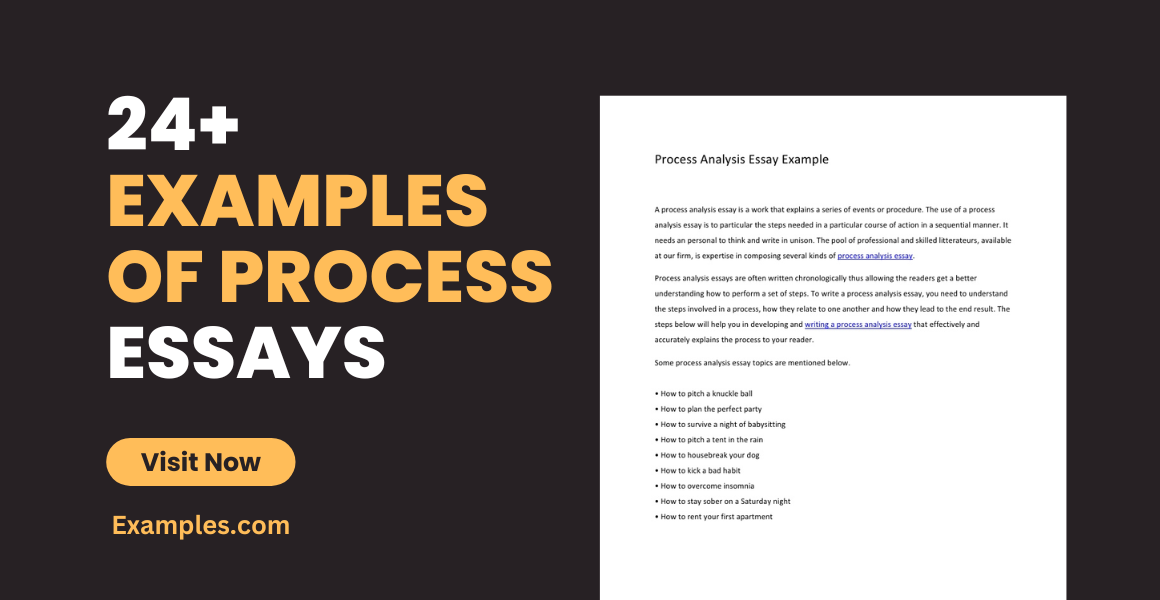
Do you know all those YouTube do-it-yourself (DIY) tutorials that they post online? When you consider posting that other than a process essay, it usually attracts more viewers and generates more subscribers on your YouTube channel as people these days are considered more visual in terms of learning new skills or facts. But process essays are just more than how-to videos or DIY videos, an accurate description of a process essay is that it simply describes a procedure. You may also see a short essay .
- 22+ examples of free essays .
- 10+ Essay Writing Examples
This kind of essay provides a step-by-step explanation of a process that leads to an expected or planned outcome. What people do not know that the aforementioned process may either be concrete or abstract. Simply put, there are two types of process essays: directional process essays (give instructions in steps on how to accomplish a specific task), and informational process essays (explains or analyzes a process). You may also see self-introduction essay
Student Process Essay Example
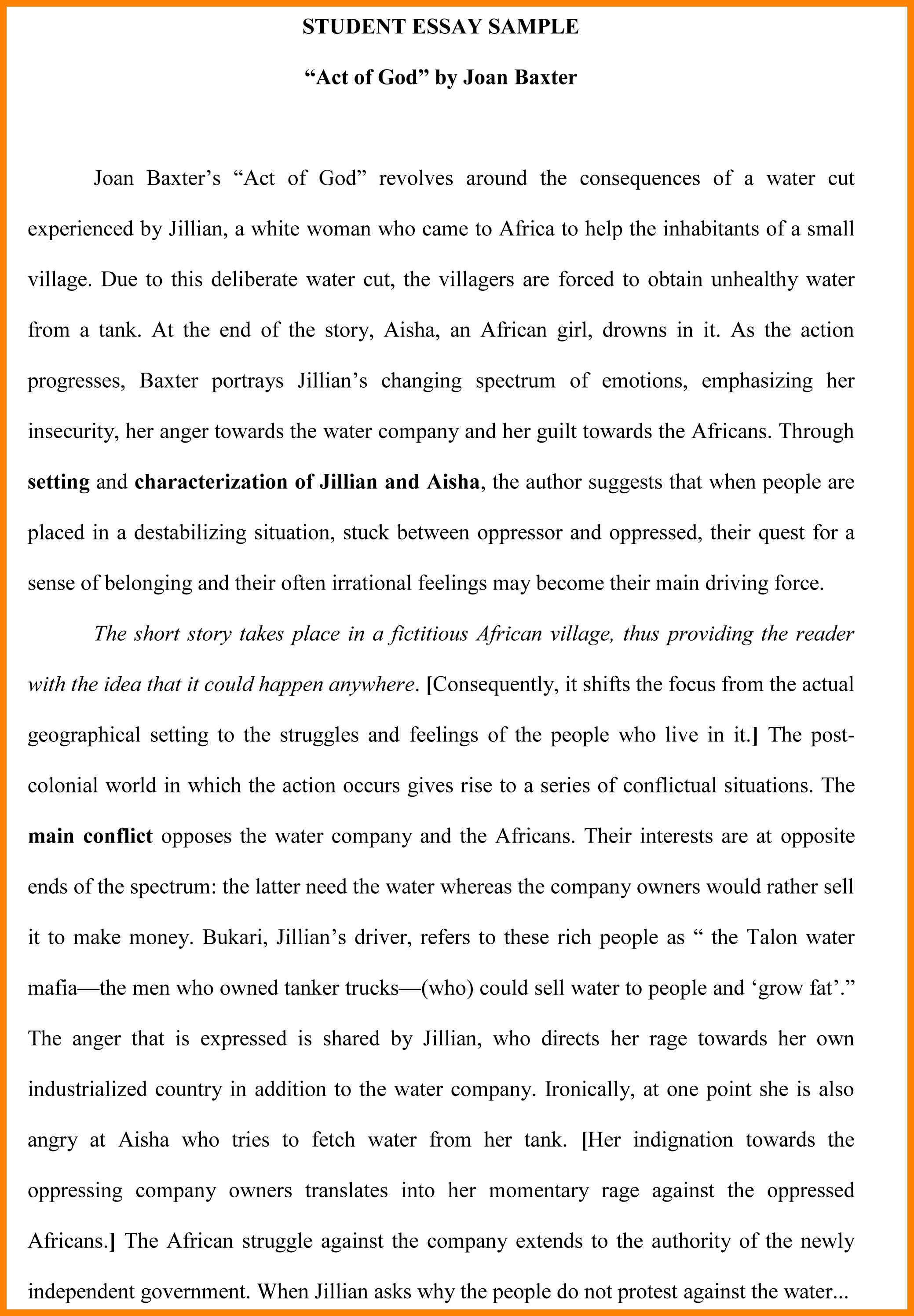
Size: 615 KB
Process Analysis Essay Example
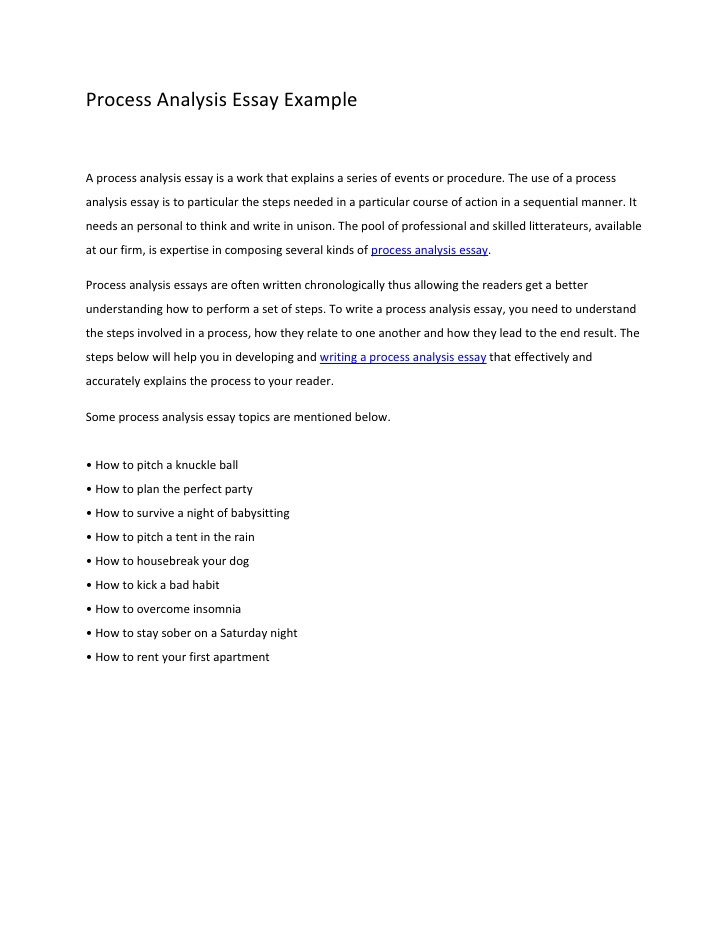
Size: 66 KB
Plain Process Essay Example
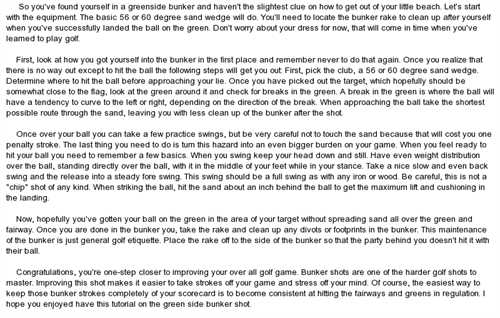
http://degregoristore.com/
Size: 53 KB

Preparation in Writing a Process Essay
1. assess your audience’s skill level.
Before you begin, you need to first take your audience’s skill level into consideration. In a lot of DIY videos and how-to videos that you see in numerous TV shows, you can see that the hosts will often make use of very simple language so that the people who decide to subscribe on their YouTube channels and watch those DIY videos will be able to understand them very easily. Another thing that you should assume is that everyone who decides to check out your videos or read your process essay has little to no knowledge of the said topic, depending on the content you decide to release or publish. Before you even begin to write your essay, you have to understand the parts that comprise an essay .
For example, a process essay intended for professional chefs could probably skip a description of how to chop carrots and just say, “Finely chop the carrots,” instead.
2. Make a list of the materials needed
If you already have an idea on what kind of process you are going to release or publish, the next thing to do would most probably be to draft a list of the materials or ingredients that your audience or viewers might need so that they can follow along. It may be easier to do so in your own DIY or “How To” videos, as it is more visual and that the viewers could clearly see as to what these products look like should they get confused, but for process essays, it is a bit tricky. One tip that you could follow would be to include a comprehensive “Things You’ll Need” section at the beginning of the paper or simply list the materials needed after the introduction so that the readers of your essay will prepare the materials needed beforehand to save precious time. There are moments in your life that you will be asked to draft up self-introduction essays as part of a class assignment.
There are times that an item on the list would seem very unusual for a person to procure. Should that be the case, such as a particular type of hand tool, be sure to clearly introduce it within the text. For instance, “The pin hammer has a finer tip than a standard hammer, making it suitable for more detailed work.” If at all possible, make sure to include a picture of the said object you are planning to use if you intend to publish the said essay online. You may also see a formal essay .
3. Create an outline of the task
In order to make things simpler for you on your end, it would be best if you created an outline that can help you create the flow of the process essay that you are working on. Keep in mind that the outline simply acts as the guide for the essay and is not the essay itself. Outlines are normally made with bullet points and at least 1 to 2 sentences per point. Creating an outline will be most helpful to especially informational process essays. Keep in mind that the more specific your article or essay topic, the more specific your details need to be. Here are some examples of how different people would write their essays .
- If your essay happens to be about cooking lasagna, you may want to begin your initial outline by saying, “Mix in basil.” Before you start writing, you could expand your outline to say, “Briefly mention taste differences between dried and fresh basil.”
- When writing an informational process essay outline about how journalists write a news report, you can include some details about journalists select a news story and the criteria they would use to determine a story’s newsworthiness.
Simple Process Essay Example
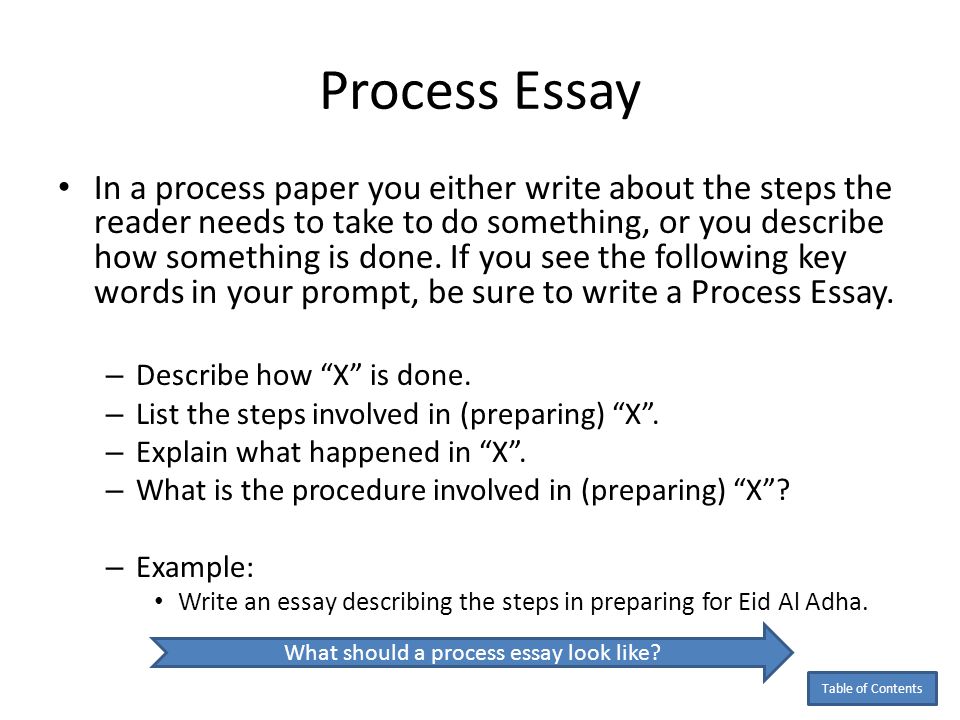
Size: 96 KB
Process Essay Example from Kool-Aid
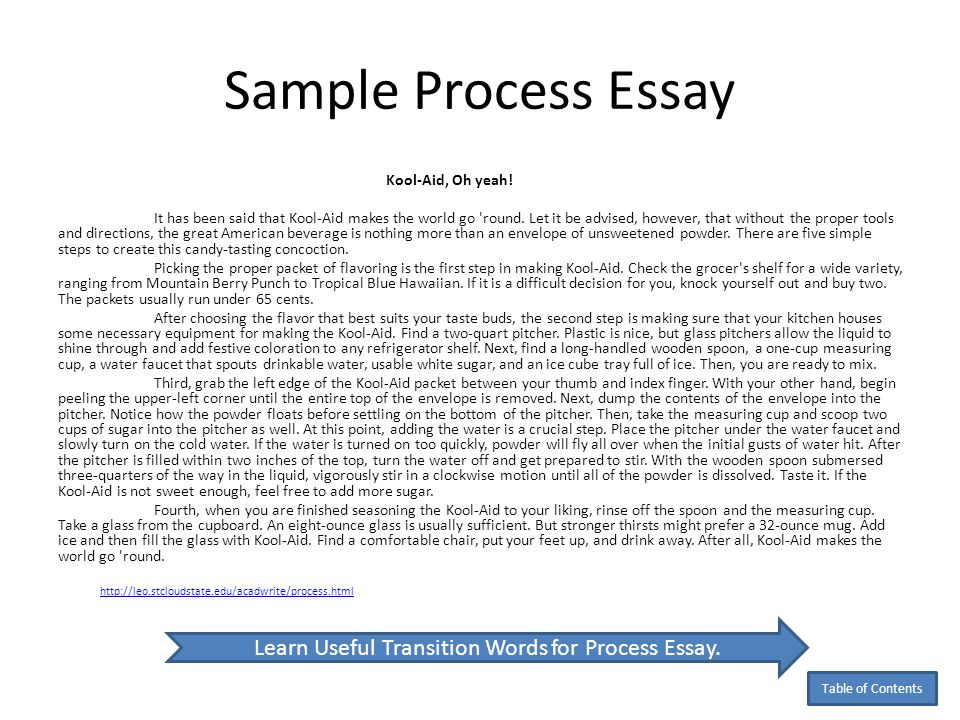
Size: 159 KB
Scanned Written Process Essay Example

Size: 76 KB
Golf Process Essay Example
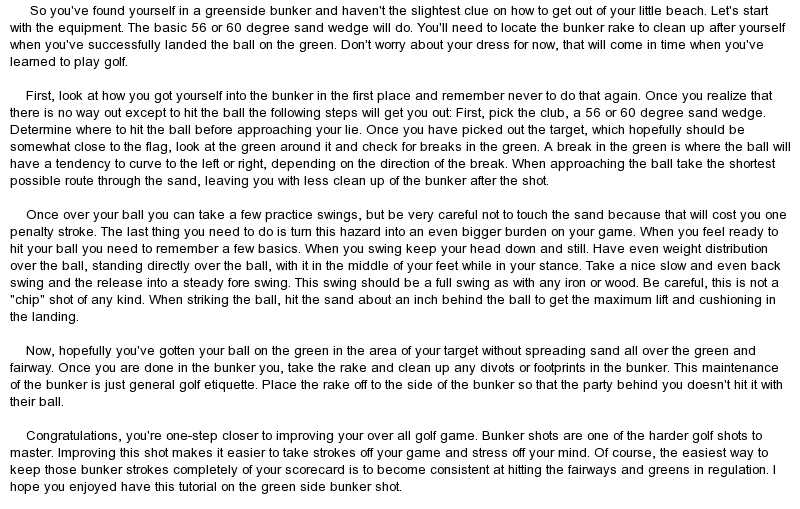
Size: 138 KB
Process Essay Example in Making Popcorn Balls
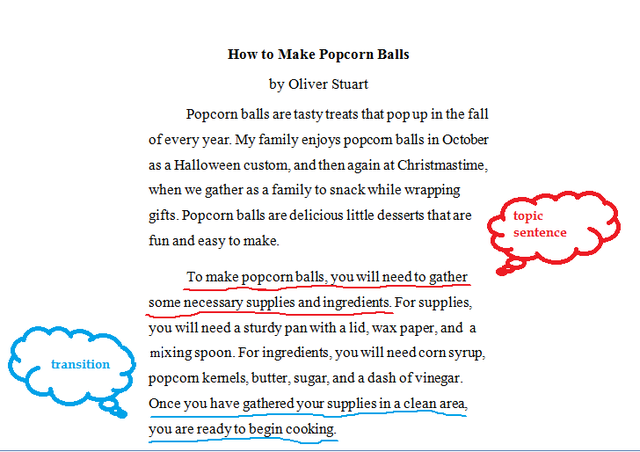
Size: 130 KB
Crafting Your Introduction
1. Grab your reader’s attention within the first 1–2 sentences. Today’s readership has a very short attention span. You see books being made into movie adaptations. Some books are being even made into TV shows for a longer and more detailed story line. Although there are some people who also prefer reading compared to watching, there are people who can tell a good book just by the first few paragraphs of the first page alone. You get that right, then you would have gained new readership. DIY and “How To” videos may be easy to create and draft a new introduction, but essays, not so much. It is usually the make or break stage for the essay. They say that when you start strong, it is just as important and vital to end strong as well. Leave the audience wanting to do more of your DIY projects or videos in the near future. Should you be interested in writing a reflective essay , you may want to click on the hyperlink on this sentence.
For instance, you might write, “The process of preparing lasagna has a rich heritage all of its own.”
2. Provide a general time estimate. Providing time estimates are very essential especially in writing these process essays as everyone might have some other plans other than doing the DIY video or following the process essay they happen to be reading. In cooking or baking, time is considered very critical. An example would be when the participants of MasterChef are asked to cook one of Gordon Ramsay’s signature dishes to avoid elimination. Even when cooking something as simple as scrambled eggs, one of the steps that Gordon suggested would be to stir over medium heat until the eggs start to cook.
The next step would be to remove the egg mix from heat and then continue stirring eggs for about 30 seconds. Return to heat, continue to stir eggs until they start to clump. He suggested that it is important to keep it “on and off” from the heat, otherwise, the eggs might be overcooked which as a result becomes watery. You would not want that to happen to your eggs, would you? Should you find yourself in need of writing an analytical essay , you may want to refer to the hyperlink found on the sentence.
3. If your process essay focuses on a cooking task, this is where you inform your audience to have some sort of clock or timer nearby for them to keep track of the number of minutes that have passed by and to place all the ingredients on the table beforehand.
4. Present the thesis statement as a problem. A thesis statement focuses your ideas into one or two sentences. It should present the topic of your paper and also make a comment about your position in relation to the topic. The thesis statement is considered to be the most important sentence of your paper as it informs the reader not only which problem you will be examining, but it should give them an idea as to how you will be able to solve the issue at hand. Your thesis statement should tell your reader what the paper is about and also help guide your writing and keep your argument focused. The thesis statement should be the last sentence of your introductory paragraph. Here are some examples of short essays that might serve as a reference in case you need assistance in formulating one.
5. You can start off your thesis statement like this, “This essay will explore how to create a complicated lasagna dish in a short period of time by preparing the noodles and sauce in advance.”
The Writing Process
Size: 25 KB
Pros and Cons of Adoption Essay Sample
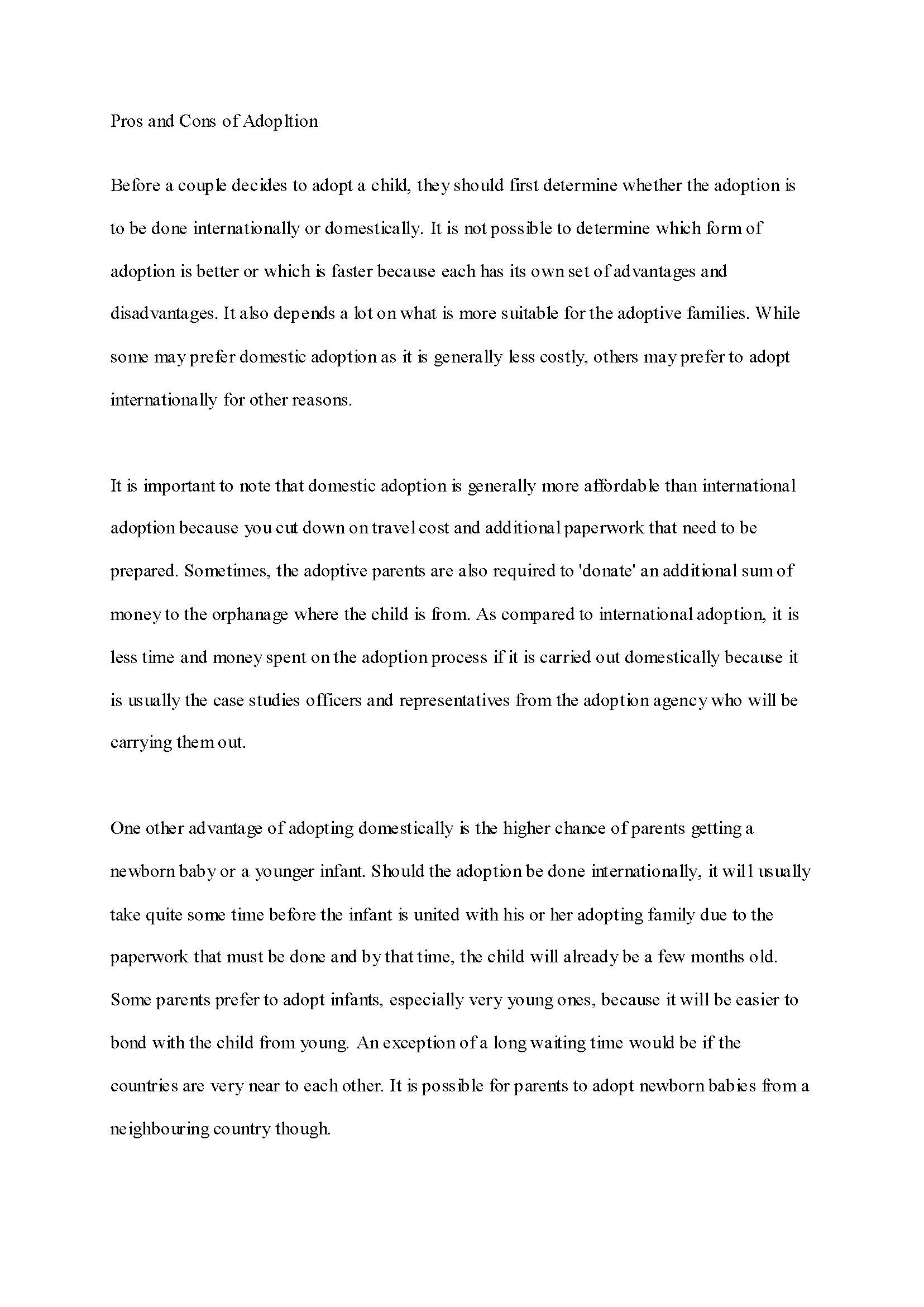
Size: 342 KB
Process Essay Example about Bathing Your Dog
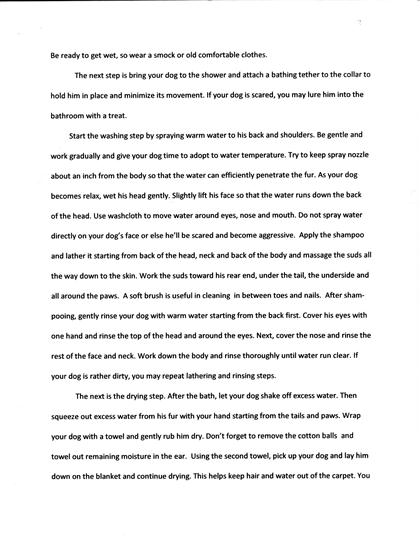
s3.amazonaws.com
Size: 45 KB
Basic Process Essay Example

Size: 756 KB
Writing Your Body Paragraphs
1. consult your outline.
People have the tendency to be sidetracked, especially when making their own stories or novels or any written work for their personal use or for their schoolwork. From time to time, it is best to try and consult with the outline that you have made as not to get lost and personally confused to where you currently are in your essay making process. As aforementioned, outlines are considered an excellent way to draft the flow of your speech or essay should you ever get lost somewhere in the middle of your essay writing. Always refer back to your bullet points if ever your point was not made somewhere in the body of the paragraph. The outline is not always right, it is merely temporary. The possibility of not following your outline might not actually exist if you have happened to draft a better one. For more ways to help start up your essay , you may refer to this hyperlink.
Try to be very careful with items that consist of multiple steps. Make the transitions clear enough and acknowledge prior steps regarding a particular item, if at all applicable.
2. Structure the body of the essay in paragraphs
The outline simply serves as the guide for your essay and is not really the speech itself. Since you have already given some thought into making the outline, now is high time to formulate the body of your essay. As much as possible, when you decide to do the initial draft of your essay, keep it in paragraph form. Bullet points may be simpler, but it is first and foremost an essay. For instance, if your process essay is about making the best shepherd’s pie, try drafting a paragraph on how to make the filling below and another paragraph on how to create good mashed potatoes on top of the lamb filling below. This, in turn, separates the two ideas for easy clarification.
Scholarship essays are normally written by applicants who wish to get their education at a lesser price, considering they uphold to the following conditions.
3. Add transitions in between steps
And since it is a process essay, it is very important that you place transitions on the steps to allow your readers to help identify as to what is Step 1 and what is Step 2. These transitions make it easier for the readers to help proceed to the next step without worrying they might have missed something on the previous step. Examples of some transitions would be the words next , first , later , then , finally , before , afterward , etc. For some examples of formal essays , you may refer to the hyperlink.
For instance, you could write, “Next, place the pot on the stove,” to move from one paragraph to the next.
4. Avoid using first-person pronouns
Including I , we , us , me , mine , our , and ours within your writing can make it seem less declarative and authoritative. In a process essay, this can make a reader less likely to trust your instructions. Instead, stick with a second and third-person perspective by using words, such as it or they . Here are some examples of argumentative essays for your reference.
For example, you could write, “This essay shows…” instead of “I’ll show.”
5. Mention any cautionary notes
Some people would normally forget to add that at the end of the process essay. This is perhaps one of the worst things that the author will not bother doing since he or she did not think that the reader will go to that extent of not following what was written. As someone who has written the process essay in the first place or a notable DIY star on YouTube, please mention some of the mistakes or actions that people tend to do when performing the said task. By doing so, you might actually save a life when you warn people beforehand. These cautionary notes serve as a warning to people as it might have already happened to some unfortunate people already. So when you are warned not to microwave your electronic devices for the sake of fun, just do not. For reference in writing personal essays , you can go through our website to find out more.
For example, you might caution a reader to “Cook the meat until it is no longer red in the center.” This advice will help them to avoid foodborne illness.
Process Essay Example about Hosting the Pre-Homecoming Dance Dinner
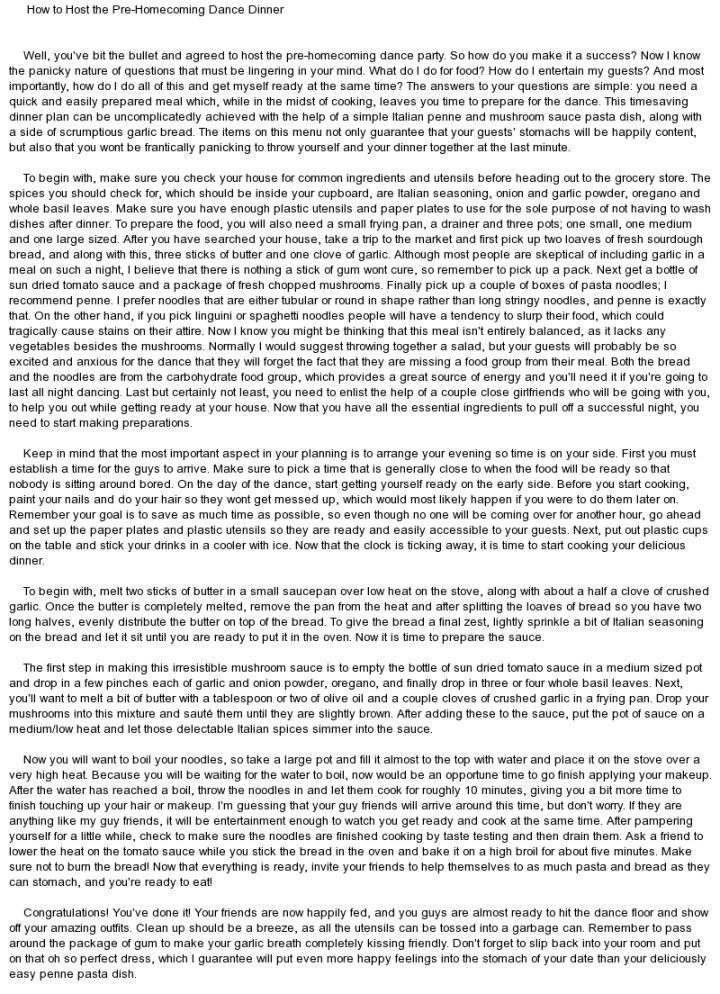
Size: 262 KB
Process Essay Writing Example
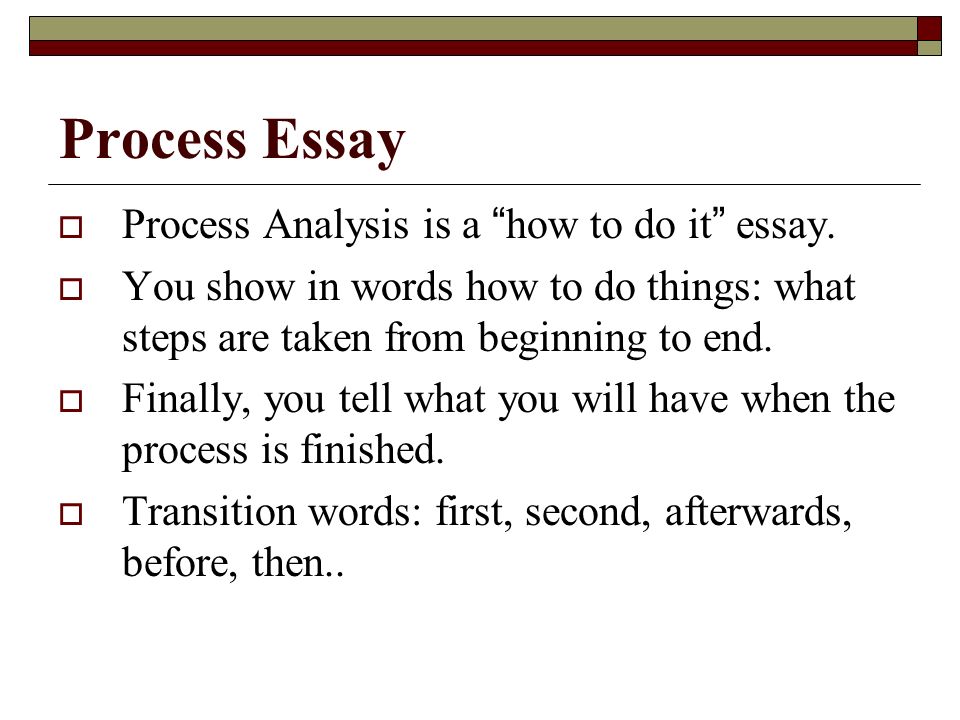
Size: 79 KB
Sample Outline of a Research Article
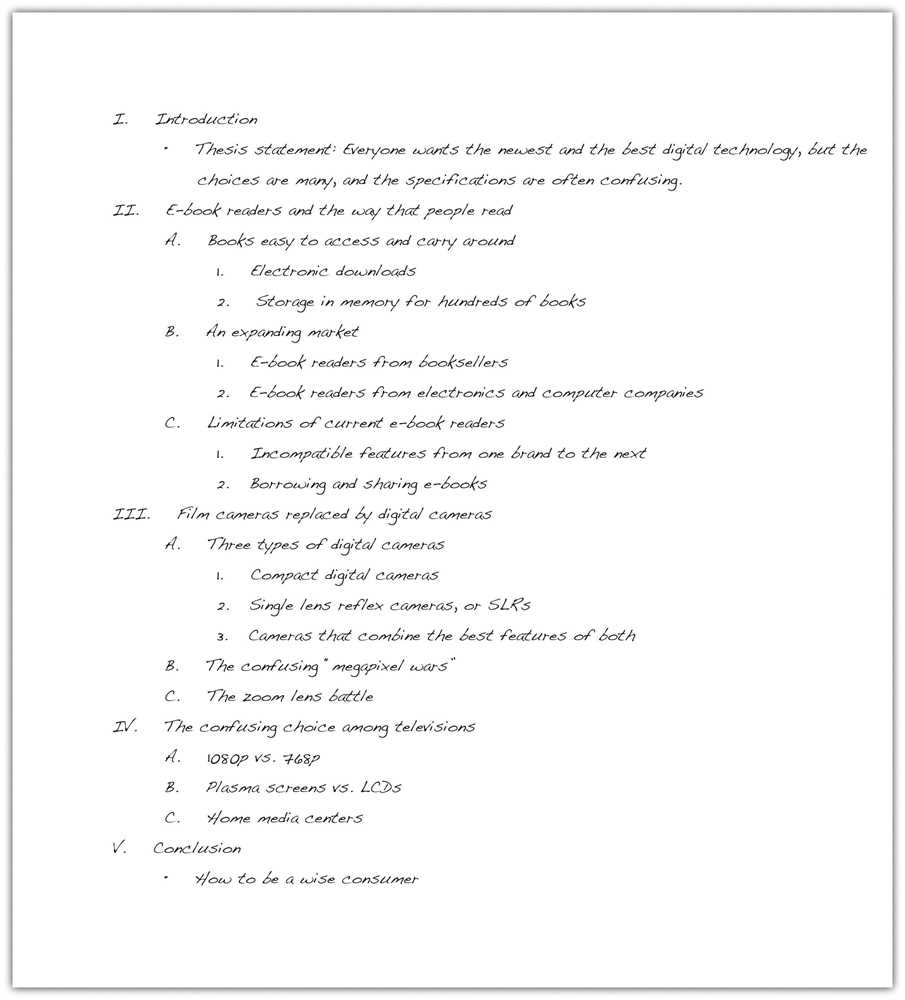
Size: 78 KB
Process Analysis Essay Writing Tips

Size: 95 KB
Odor Nuisances Sample Essay
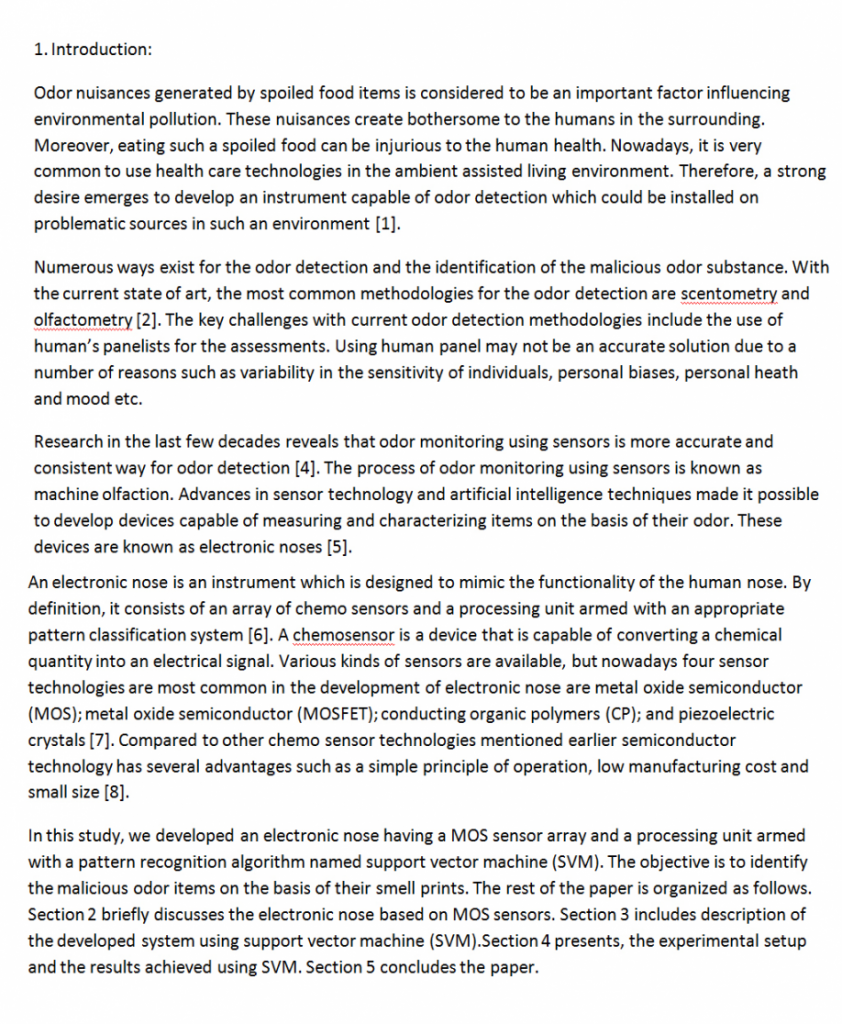
Size: 776 KB
The Process of Building Stonehenge Research Paper
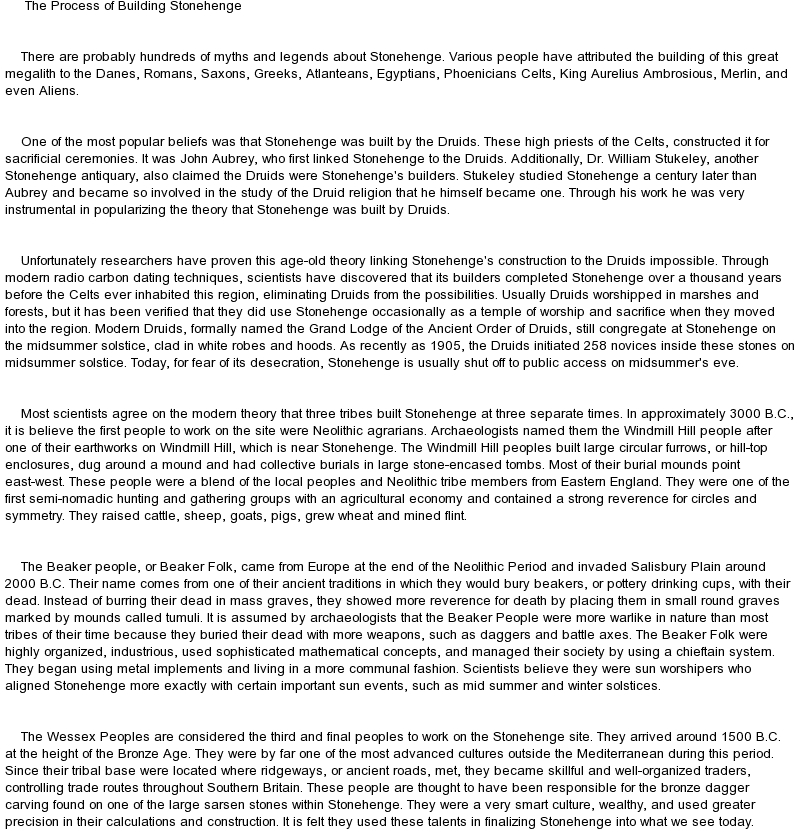
Size: 241 KB
Wrapping It Up
1. Mention the end product and what to do with it. At the last few minutes of the DIY video or the process essay, you can see that you are almost through making the said product. Now, there are some people who might already have an idea of what to do with them. For example, let us say that you are done making the recipe for the coffee jelly dessert. You can provide suggestions as what to do with the coffee jelly that you have made (e.g., After cutting the coffee jelly into cubes, pour it into a tall glass and pour some cold-brewed coffee to give it that extra flavor. And finally, top it off with some ice cream and place a spoon or straw. Best served chilled with family and friends). Here are some tips and examples that you might need when writing a thesis statement for your narrative .
2. Restate the importance of the task. Cooking has proven itself to be quite a challenge, especially when one has no background or experience in cooking. It can otherwise be daunting, and there will be times that you will feel like passing out or giving up. But if you hold on to the very reason as to why you are doing it in the first place, it will keep you focused on completing the task at hand quicker than expected. To be quite fair and frank, this is often utilized by marketing stunts everywhere even in making DIY arts and crafts projects for Father’s Day and Mother’s Day. Here are some examples of persuasive essays that can serve as a reference when writing essays.
3. A basic example of a newly-made dinner intended for your parents’ anniversary might be, “And there you have it! A delicious yet quick meal fit for the two of them to enjoy which looks complicated and sophisticated but is actually simple enough with enough practice. Next time, experiment with different herbs and spices to find your own spin on this classic dish.”
4. Check your essay for ease of reading. Now that you are through writing your essay, the next best logical thing to do would be to actually take some time to review them. If you think you are satisfied with the flow of the essay that you have written, then you may publish it with ease. But if you do not think you are comfortable or assume that there is something lacking in the process essay, take the time to double-check the content and add the necessary content to the essay. While you are in the middle of double-checking, try adding a few final touches to your essay for it to sound better. Lend your essay to a friend or family member to check if they had understood the whole process. Here are some examples of academic essays .
5. One tip would be to see if there are certain steps that you can eliminate or condense your instructions as not to take up too much space in the essay. A reader is more likely to finish directions that they can easily skim through.
6. Proofread your essay. Finally, proofread your essay. Don’t rely on spell-check alone, as it cannot account for context and doesn’t catch every error. But other than spell-checking your essay, make sure to also check for typographical errors in terms of grammar and preposition, subject-verb agreement, etc. Keep in mind that people from all over will be reading your essay, so make sure that it is written professionally in whatever language you will be using. Here are some examples of high school essays that you can refer to.
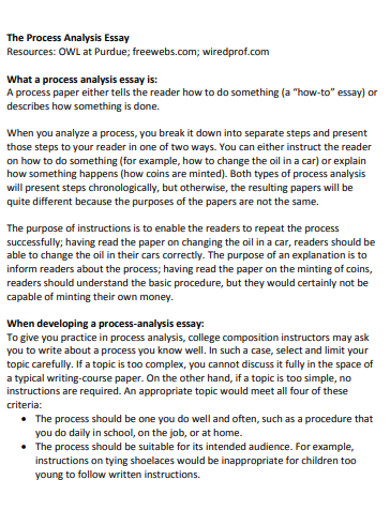
Size: 198 KB
Expository or Process Essay Example
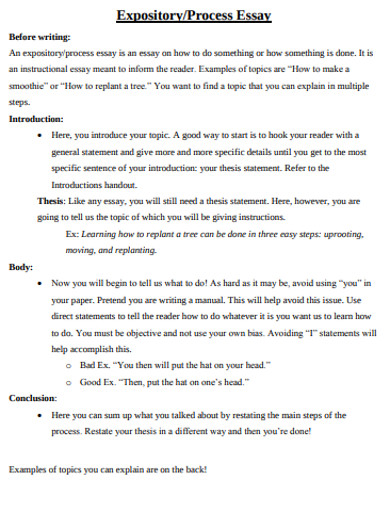
Size: 329 KB
Minimalist Process Essay Example
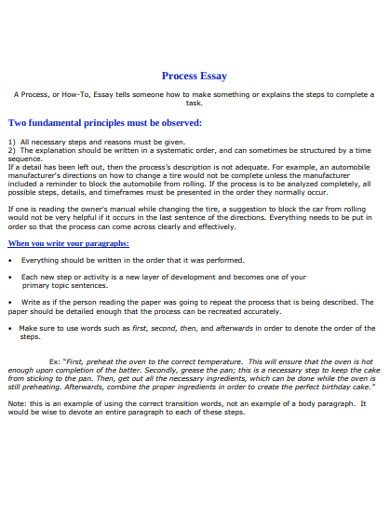
Size: 90 KB
Process Essay Example in PDF
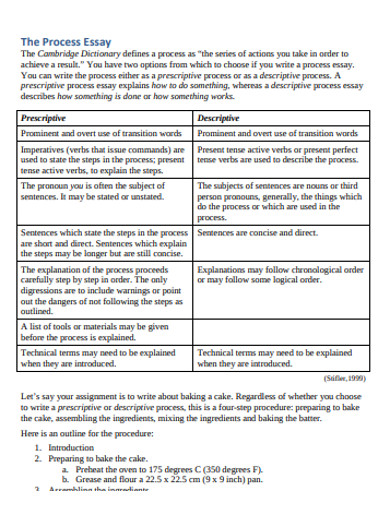
Size: 109 KB
Fundamental Process Essay Example

Size: 64 KB
Cheerleading Routine Process Essay Analysis Example
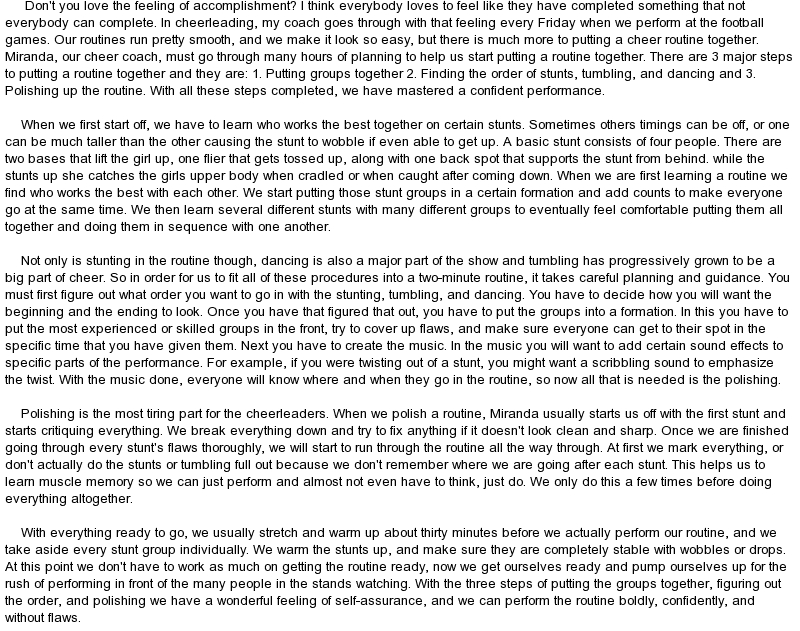
Size: 220 KB
Interesting Process Essay Ideas to Write in 2019
2019 is considered the “Year of the Earth Pig.” This could indicate laziness; however, it could also depict enthusiasm for some people. Considering that the usage of social media and the internet in this year is prevalent, people tend to view loads of various information that shape their own perspective. Moreover, this era strongly pushes the empowerment for every individual to showcase themselves, abling them to do what they want to do. Conclusively, the freedom of this age provides people a wide variety of interests.
A process essay explains the how-tos of a certain topic. Now that you already tackled the basics of this composition as well as the steps in making one, we are giving you in this section some exciting ideas that you can use in writing your own process essay for this year, 2019. According to your preference, you may consider selecting from these topics:
1. Technology-based ideas
2019 is a year that belongs to an era of rapidly innovating technology where gadgets and internet are major tools for almost everybody. Hence, it is not a surprise that people commonly ask some steps regarding technology. In writing your 2019 process essay, here are some examples of technology-based ideas:
- How to create your own Facebook account?
- How to reboot your phone?
- How to create your own Instagram account?
- How to upload several pictures on Facebook in 3 simple clicks?
- How to invite someone to play an online game?
- How to rank up in Mobile Legends?
- How to call someone via Messenger?
- How to use Snapchat as a newbie?
- Step-by-step guide in composing your first tweet
- How to perform a factory reset on your phone?
2. Smart aesthetic hack ideas
The presence of the internet also paved the way for beauty online influencers to showcase their own intelligent ideas. Consisted of mostly females, different channels and blogs fascinate their audience with their various mind-blowing hacks in grooming oneself. They also give some out-of-the-box solutions to the common aesthetic dilemmas. Basically, topics under this section range from fashion to beauty tips bonanza which include:
- How to transform a shirt into a skirt?
- How to rescue your shattered face powder?
- DIY T-shirt printing
- How to brush teeth the correct way?
- Alternative ways to curl hair
- How to make your own anime costume?
- How to make your own natural body scrub?
- How to do your full-face make-up in 3 easy steps?
- How to select the perfect sunglass for you?
- How to distinguish fake jewelry from genuine ones?
An important reminder, try to talk about processes that do not involve your audience’s health, especially if you are not a professional or your step is not yet widely studied.
3. Cooking hack ideas
Food is a basic necessity for each individual and just like the previous one, the internet also provided the cooking pros a medium to share their impressive easy-to-do recipes and strategies in preparing edibles. This extends from simple snacks and desserts to meals of rare occasions, turning simple white plates to something you can boast your friends of. These ideas may include:
- How to make a home-made chocolate fudge?
- Simple steps in making a no-bake cake
- How to slice onions the correct way?
- Impressive ways to plate your meal
- Easy-to-make soup recipes
- How to brine a turkey?
- How to make the perfect sandwich for your kids?
- How to boil eggs perfectly?
- How to remove avocado seed fast?
- Step-by-step guide in assembling cake layers

Process Essay Generator
Text prompt
- Instructive
- Professional
Write a Process Essay on how to prepare for a high school exam.
Discuss the steps involved in writing a research paper for your Process Essay.
- The Writing Process
- Addressing the Prompt
- Writing Skill: Development
- Originality
- Timed Writing (Expectations)
- Integrated Writing (Writing Process)
- Introduction to Academic Essays
- Organization
- Introduction Paragraphs
- Body Paragraphs
- Conclusion Paragraphs
- Example Essay 1
- Example Essay 2
- Timed Writing (The Prompt)
- Integrated Writing (TOEFL Task 1)
- Process Essays
Process Essay Example 1
- Process Essay Example 2
- Writing Skill: Unity
- Revise A Process Essay
- Timed Writing (Choose a Position)
- Integrated Writing (TOEFL Task 2)
- Comparison Essays
- Comparison Essay Example 1
- Comparison Essay Example 2
- Writing Skill: Cohesion
- Revise A Comparison Essay
- Timed Writing (Plans & Problems)
- Integrated Writing (Word Choice)
- Problem/Solution Essays
- Problem/Solution Essay Example 1
- Problem/Solution Example Essay 2
- Writing Skill: Summary
- Revise A Problem/Solution Essay
- Timed Writing (Revising)
- Integrated Writing (Summary)
- More Writing Skills
- Punctuation
- Simple Sentences
- Compound Sentences
- Complex Sentences Part 1
- Complex Sentences Part 2
- Using Academic Vocabulary
- Translations
Choose a Sign-in Option
Tools and Settings
Questions and Tasks
Citation and Embed Code

How to Live a Happy Life
People are always searching for things that make them happy. For example, many people work very hard to improve their employment because they want to find a better job to make themselves happy. Other people search for happiness by purchasing things they want. It is not bad to search for happiness, but many people do not understand that lasting happiness does not depend on having certain things. It doesn’t depend on the circumstances of a person’s life. It depends more on how life is lived and people are loved. There are things that people can do to live a happy life regardless of their situation. In order to live a happy life, people should build relationships, be grateful, and help others.
The first thing that people should do to live a happy life is build relationships with other people. Building relationships can include both making new friends and strengthening relationships that already exist with friends and family members. These relationships lead to greater happiness because people who have strong connections with other people are less lonely, especially in difficult times. They have people who they can talk to and people who can offer comfort to them. Another reason that strong connections can increase happiness is that they create a network of people who can offer advice. Knowing that there are friends who can offer this advice to help solve a problem can help people feel happier. Strong relationships also lead to greater feelings of belonging and security, which in turn, lead to greater happiness. Building these relationships is an essential step to living a happy life.
In addition to nurturing relationships, people who want to be happy should be grateful. People who are grateful open their eyes to see all of the good things in their lives, and they express gratitude to people who help them. Many people have noticed that by opening their eyes to see the good things they have and choosing to have gratitude, their perspective changes. They spend more time focusing on positive thoughts instead of focusing on things that are negative or difficult. Thoughts create perspective, so intentionally creating positive thoughts will lead to a more positive perspective. Regardless of struggles they have, they choose to focus on the gifts they can see. Gratitude can change people’s perspective and help them be happier, regardless of their situation.
Finally, serving others can make people happier. Serving others can include doing simple things like listening to a friend who is having a hard time or preparing a meal to share with someone who is sick. These simple acts not only improve another person’s life, but they also bring happiness to the person who is serving. This happiness is a natural result of lifting another person’s burden. Helping others also helps in the other areas of building happiness: it strengthens relationships with others and it helps people feel more gratitude. When people serve others, they can become good friends by showing how much they care and want to help. People feel more gratitude because when they see the problems other people face, they find ways that their life is blessed. Serving others is an essential key to living a happier life.
If people want to have a happier life, they should serve others, be grateful, and strengthen their relationships with other people. Each of these things focuses on people and perspective rather than money and material possessions. People bring joy to other people in a way that possessions can never imitate. Perspective can make a lasting impact on a person’s life in a way that a promotion simply can’t. Regardless of the circumstances of an individual’s life, that individual can choose to focus on happiness in a real, genuine way if he wants to. Finding lasting happiness is really a simple search. That search begins as soon as people start looking beyond temporary things that only bring temporary happiness.
Exercise: Analyze an essay
Read one of the two Process Example Essays on the following pages to complete this exercise.
- Label the introduction paragraph, the body paragraphs, and the conclusion paragraph.
- Circle the hook.
- What is the general topic of the essay?
- Underline the thesis.
- Underline each of the topic sentences.
- Do each of the topic sentences support the thesis?
- Does the conclusion paragraph start by restating the thesis?
This content is provided to you freely by EdTech Books.
Access it online or download it at https://edtechbooks.org/academic_a_writing/process_essay_exampl .
Have a language expert improve your writing
Run a free plagiarism check in 10 minutes, generate accurate citations for free.
- Knowledge Base
- Example of a great essay | Explanations, tips & tricks
Example of a Great Essay | Explanations, Tips & Tricks
Published on February 9, 2015 by Shane Bryson . Revised on July 23, 2023 by Shona McCombes.
This example guides you through the structure of an essay. It shows how to build an effective introduction , focused paragraphs , clear transitions between ideas, and a strong conclusion .
Each paragraph addresses a single central point, introduced by a topic sentence , and each point is directly related to the thesis statement .
As you read, hover over the highlighted parts to learn what they do and why they work.
Instantly correct all language mistakes in your text
Upload your document to correct all your mistakes in minutes

Table of contents
Other interesting articles, frequently asked questions about writing an essay, an appeal to the senses: the development of the braille system in nineteenth-century france.
The invention of Braille was a major turning point in the history of disability. The writing system of raised dots used by visually impaired people was developed by Louis Braille in nineteenth-century France. In a society that did not value disabled people in general, blindness was particularly stigmatized, and lack of access to reading and writing was a significant barrier to social participation. The idea of tactile reading was not entirely new, but existing methods based on sighted systems were difficult to learn and use. As the first writing system designed for blind people’s needs, Braille was a groundbreaking new accessibility tool. It not only provided practical benefits, but also helped change the cultural status of blindness. This essay begins by discussing the situation of blind people in nineteenth-century Europe. It then describes the invention of Braille and the gradual process of its acceptance within blind education. Subsequently, it explores the wide-ranging effects of this invention on blind people’s social and cultural lives.
Lack of access to reading and writing put blind people at a serious disadvantage in nineteenth-century society. Text was one of the primary methods through which people engaged with culture, communicated with others, and accessed information; without a well-developed reading system that did not rely on sight, blind people were excluded from social participation (Weygand, 2009). While disabled people in general suffered from discrimination, blindness was widely viewed as the worst disability, and it was commonly believed that blind people were incapable of pursuing a profession or improving themselves through culture (Weygand, 2009). This demonstrates the importance of reading and writing to social status at the time: without access to text, it was considered impossible to fully participate in society. Blind people were excluded from the sighted world, but also entirely dependent on sighted people for information and education.
In France, debates about how to deal with disability led to the adoption of different strategies over time. While people with temporary difficulties were able to access public welfare, the most common response to people with long-term disabilities, such as hearing or vision loss, was to group them together in institutions (Tombs, 1996). At first, a joint institute for the blind and deaf was created, and although the partnership was motivated more by financial considerations than by the well-being of the residents, the institute aimed to help people develop skills valuable to society (Weygand, 2009). Eventually blind institutions were separated from deaf institutions, and the focus shifted towards education of the blind, as was the case for the Royal Institute for Blind Youth, which Louis Braille attended (Jimenez et al, 2009). The growing acknowledgement of the uniqueness of different disabilities led to more targeted education strategies, fostering an environment in which the benefits of a specifically blind education could be more widely recognized.
Several different systems of tactile reading can be seen as forerunners to the method Louis Braille developed, but these systems were all developed based on the sighted system. The Royal Institute for Blind Youth in Paris taught the students to read embossed roman letters, a method created by the school’s founder, Valentin Hauy (Jimenez et al., 2009). Reading this way proved to be a rather arduous task, as the letters were difficult to distinguish by touch. The embossed letter method was based on the reading system of sighted people, with minimal adaptation for those with vision loss. As a result, this method did not gain significant success among blind students.
Louis Braille was bound to be influenced by his school’s founder, but the most influential pre-Braille tactile reading system was Charles Barbier’s night writing. A soldier in Napoleon’s army, Barbier developed a system in 1819 that used 12 dots with a five line musical staff (Kersten, 1997). His intention was to develop a system that would allow the military to communicate at night without the need for light (Herron, 2009). The code developed by Barbier was phonetic (Jimenez et al., 2009); in other words, the code was designed for sighted people and was based on the sounds of words, not on an actual alphabet. Barbier discovered that variants of raised dots within a square were the easiest method of reading by touch (Jimenez et al., 2009). This system proved effective for the transmission of short messages between military personnel, but the symbols were too large for the fingertip, greatly reducing the speed at which a message could be read (Herron, 2009). For this reason, it was unsuitable for daily use and was not widely adopted in the blind community.
Nevertheless, Barbier’s military dot system was more efficient than Hauy’s embossed letters, and it provided the framework within which Louis Braille developed his method. Barbier’s system, with its dashes and dots, could form over 4000 combinations (Jimenez et al., 2009). Compared to the 26 letters of the Latin alphabet, this was an absurdly high number. Braille kept the raised dot form, but developed a more manageable system that would reflect the sighted alphabet. He replaced Barbier’s dashes and dots with just six dots in a rectangular configuration (Jimenez et al., 2009). The result was that the blind population in France had a tactile reading system using dots (like Barbier’s) that was based on the structure of the sighted alphabet (like Hauy’s); crucially, this system was the first developed specifically for the purposes of the blind.
While the Braille system gained immediate popularity with the blind students at the Institute in Paris, it had to gain acceptance among the sighted before its adoption throughout France. This support was necessary because sighted teachers and leaders had ultimate control over the propagation of Braille resources. Many of the teachers at the Royal Institute for Blind Youth resisted learning Braille’s system because they found the tactile method of reading difficult to learn (Bullock & Galst, 2009). This resistance was symptomatic of the prevalent attitude that the blind population had to adapt to the sighted world rather than develop their own tools and methods. Over time, however, with the increasing impetus to make social contribution possible for all, teachers began to appreciate the usefulness of Braille’s system (Bullock & Galst, 2009), realizing that access to reading could help improve the productivity and integration of people with vision loss. It took approximately 30 years, but the French government eventually approved the Braille system, and it was established throughout the country (Bullock & Galst, 2009).
Although Blind people remained marginalized throughout the nineteenth century, the Braille system granted them growing opportunities for social participation. Most obviously, Braille allowed people with vision loss to read the same alphabet used by sighted people (Bullock & Galst, 2009), allowing them to participate in certain cultural experiences previously unavailable to them. Written works, such as books and poetry, had previously been inaccessible to the blind population without the aid of a reader, limiting their autonomy. As books began to be distributed in Braille, this barrier was reduced, enabling people with vision loss to access information autonomously. The closing of the gap between the abilities of blind and the sighted contributed to a gradual shift in blind people’s status, lessening the cultural perception of the blind as essentially different and facilitating greater social integration.
The Braille system also had important cultural effects beyond the sphere of written culture. Its invention later led to the development of a music notation system for the blind, although Louis Braille did not develop this system himself (Jimenez, et al., 2009). This development helped remove a cultural obstacle that had been introduced by the popularization of written musical notation in the early 1500s. While music had previously been an arena in which the blind could participate on equal footing, the transition from memory-based performance to notation-based performance meant that blind musicians were no longer able to compete with sighted musicians (Kersten, 1997). As a result, a tactile musical notation system became necessary for professional equality between blind and sighted musicians (Kersten, 1997).
Braille paved the way for dramatic cultural changes in the way blind people were treated and the opportunities available to them. Louis Braille’s innovation was to reimagine existing reading systems from a blind perspective, and the success of this invention required sighted teachers to adapt to their students’ reality instead of the other way around. In this sense, Braille helped drive broader social changes in the status of blindness. New accessibility tools provide practical advantages to those who need them, but they can also change the perspectives and attitudes of those who do not.
Bullock, J. D., & Galst, J. M. (2009). The Story of Louis Braille. Archives of Ophthalmology , 127(11), 1532. https://doi.org/10.1001/archophthalmol.2009.286.
Herron, M. (2009, May 6). Blind visionary. Retrieved from https://eandt.theiet.org/content/articles/2009/05/blind-visionary/.
Jiménez, J., Olea, J., Torres, J., Alonso, I., Harder, D., & Fischer, K. (2009). Biography of Louis Braille and Invention of the Braille Alphabet. Survey of Ophthalmology , 54(1), 142–149. https://doi.org/10.1016/j.survophthal.2008.10.006.
Kersten, F.G. (1997). The history and development of Braille music methodology. The Bulletin of Historical Research in Music Education , 18(2). Retrieved from https://www.jstor.org/stable/40214926.
Mellor, C.M. (2006). Louis Braille: A touch of genius . Boston: National Braille Press.
Tombs, R. (1996). France: 1814-1914 . London: Pearson Education Ltd.
Weygand, Z. (2009). The blind in French society from the Middle Ages to the century of Louis Braille . Stanford: Stanford University Press.
If you want to know more about AI tools , college essays , or fallacies make sure to check out some of our other articles with explanations and examples or go directly to our tools!
- Ad hominem fallacy
- Post hoc fallacy
- Appeal to authority fallacy
- False cause fallacy
- Sunk cost fallacy
College essays
- Choosing Essay Topic
- Write a College Essay
- Write a Diversity Essay
- College Essay Format & Structure
- Comparing and Contrasting in an Essay
(AI) Tools
- Grammar Checker
- Paraphrasing Tool
- Text Summarizer
- AI Detector
- Plagiarism Checker
- Citation Generator
Prevent plagiarism. Run a free check.
An essay is a focused piece of writing that explains, argues, describes, or narrates.
In high school, you may have to write many different types of essays to develop your writing skills.
Academic essays at college level are usually argumentative : you develop a clear thesis about your topic and make a case for your position using evidence, analysis and interpretation.
The structure of an essay is divided into an introduction that presents your topic and thesis statement , a body containing your in-depth analysis and arguments, and a conclusion wrapping up your ideas.
The structure of the body is flexible, but you should always spend some time thinking about how you can organize your essay to best serve your ideas.
Your essay introduction should include three main things, in this order:
- An opening hook to catch the reader’s attention.
- Relevant background information that the reader needs to know.
- A thesis statement that presents your main point or argument.
The length of each part depends on the length and complexity of your essay .
A thesis statement is a sentence that sums up the central point of your paper or essay . Everything else you write should relate to this key idea.
A topic sentence is a sentence that expresses the main point of a paragraph . Everything else in the paragraph should relate to the topic sentence.
At college level, you must properly cite your sources in all essays , research papers , and other academic texts (except exams and in-class exercises).
Add a citation whenever you quote , paraphrase , or summarize information or ideas from a source. You should also give full source details in a bibliography or reference list at the end of your text.
The exact format of your citations depends on which citation style you are instructed to use. The most common styles are APA , MLA , and Chicago .
Cite this Scribbr article
If you want to cite this source, you can copy and paste the citation or click the “Cite this Scribbr article” button to automatically add the citation to our free Citation Generator.
Bryson, S. (2023, July 23). Example of a Great Essay | Explanations, Tips & Tricks. Scribbr. Retrieved April 2, 2024, from https://www.scribbr.com/academic-essay/example-essay-structure/
Is this article helpful?
Shane Bryson
Shane finished his master's degree in English literature in 2013 and has been working as a writing tutor and editor since 2009. He began proofreading and editing essays with Scribbr in early summer, 2014.
Other students also liked
How to write an essay introduction | 4 steps & examples, academic paragraph structure | step-by-step guide & examples, how to write topic sentences | 4 steps, examples & purpose, unlimited academic ai-proofreading.
✔ Document error-free in 5minutes ✔ Unlimited document corrections ✔ Specialized in correcting academic texts
92 Criminal Procedure Essay Topic Ideas & Examples
🏆 best criminal procedure topic ideas & essay examples, 📝 good research topics about criminal procedures, ⭐ simple & easy criminal procedure essay titles, ❓ criminal procedure essay questions.
- Criminal Procedure: Arrest In addition, the arrest can be made without a warrant if, a person commits the offense in the presence of a law enforcement officer.
- Criminal Procedure: Establishing Probable Cause to Search Truck For a search and arrest warrants to be issued, the requirements include that the officer produces a probability cause, which justifies the search. We will write a custom essay specifically for you by our professional experts 808 writers online Learn More
- Pretrial Procedures in Criminal Justice Therefore, studying the processes that take place before the trial is important for understanding the overall delivery of criminal justice. Before the trial begins, the defense attorney and the prosecutor must prepare for it.
- Constitutional Rights and Criminal Procedures Due to the amendment the court has to interpret and protect the sixth Amendment to a wide range of criminal justice system.
- Criminal Procedures in The Innocent Man by J. Grisham The circumstances surrounding his life were perfect for the police to put the blame for the recent murder on him, and the evidence found on the scene of the crime scantly connected Williamson with it […]
- Researching of Criminal Law and Procedure For example, one spouse may claim that the substance belongs to the other; thus, the attorney is likely not to diligently and competently represent the claimant.
- The Nationalization and Constitutionalization of Criminal Procedure It included the Fourteenth Amendment Due Process Case’s interpretation for extending the protections of the Bill of the Rights to states.
- Analysis and Application of Criminal Procedures In this hypothetical situation, the police officer did not contravene the Fourth Amendment to the United States Constitution. However, since he agreed, the action of the officer to talk to him is justifiable.
- Techniques of Neutralization in Criminal Procedures The idea behind the formulation of the techniques of neutralization came from the differential association theory. In the article, Scully and Marolla were trying to put to practice the concept of techniques of neutralization.
- Aspects of Criminal Procedure The government is also expected to present convincing evidence of the defendant’s presence at the scene of the crime on the said date.
- Criminal Procedure: Stop & Frisk In addition, it will also include other related issues brought about by stop and frisk, including the right to stop and frisk, reactions from the community, cases and other issues of interests, as well as […]
- The Warren Court’s Rulings and Criminal Procedure Police also inform the suspects that they have the right to an attorney that will be provided to them by the state if they cannot afford one.
- Civil and Criminal Procedure Laws in Hong Kong The concept simply means that the rule of law is the supreme authority in the land. The rule referred to in this case defines the behaviour of individuals in a given society.
- Criminal Identification Procedures in the 21st Century It has emerged that these advances have significant effects on the efficiency of the criminal justice system, particularly from the perspective of crime control. Databases for DNA are in the custody of the government in […]
- Modernization of Criminal Procedures in South America The new Code is meant to preserve the rights of the accused in the course of criminal procedures for instance habeas corpus and through the limitation of precautionary detention.
- Interrogation Techniques in the Criminal Procedure The concept of lying is the most worrying one in the process of interrogation, since the facts on which the investigation may be based have to be well-checked and grounded otherwise they will be useless […]
- Military Trials: The Criminal Justice Procedures Violations According to the currently established procedure of most of the states, the accused has the right to gain access to all of the evidence at any time in the process.
- United States Constitution and Criminal Procedure The view of the role of the judiciary and the rule of law in society is also provided in the paper.
- Steps of Criminal Procedure in US If law-enforcing agents conducting the arrest violate any of the provisions, then the arrestees have the right to refuse all the prosecution evidences presented in court.
- Criminal Procedure Policy In the final part, the appropriateness of the Bill of Rights to the states with respect to the 14th Amendment is illustrated.
- Criminal Identification Procedures One of the interesting applications of technology to crime prevention is the use of cameras. The overall effect is that the presence of CCTV cameras increases the sense of security in a given place.
- Pre-trial Procedures in Criminal Cases The prosecutors have the obligation to use the material evidence to defend the criminal, failure to which, the suspect would seek some lawsuit later. Therefore, the prosecutor is obliged to disclose material evidence in favor […]
- Civil Procedure vs. Criminal Procedure: Comparative Analysis
- Comparing and Contrasting Approaches to Criminal Procedure U.S. Supreme Court
- Courts and Criminal Procedure of the United States
- Criminal Procedure and the Constitution – Brown vs. Texas
- Difference Between Civil Law and Criminal Procedure
- Discretionary vs. Mandatory Prosecution: A Game-Theoretic Approach to Comparative Criminal Procedure
- Due Process and Crime Control Models: Shaping Criminal Procedure Policy
- Hemp Legislation and the Global Economy: Criminal Law and Procedure
- A Common Procedure in the US Justice System
- Correlation Between Inequality and Adversarial Criminal Procedure
- Law, Tort Law, Criminal Law, Contracts, and Civil Procedure
- Legal Counsel Before the 1996 Chinese Criminal Procedure Law
- Legality and Reality: Some Evidence on Criminal Procedure
- Analysis of Miranda vs. Arizona and Criminal Procedure
- Optimal Criminal Procedure: Fairness and Deterrence
- Political Influence Over Supreme Court Criminal Procedure Cases
- Punitive Police? Agency Costs, Law Enforcement, and Criminal Procedure
- The Criminal Action Procedure Is Justified Innocent or Guilty
- The Inquisitorial and the Adversarial Procedure in a Criminal Court Setting
- The U.S. Criminal Procedure and Corrections Overview
- The Main Concepts to Know About Criminal Profiling
- Differences Between the Due Process Model and the Crime Control Procedure Model
- The US and Australian Criminal Procedures Comparative Analysis
- History of Criminal Procedure and the Constitution
- Probable Cause and Criminal Procedure Overview
- Theoretical Foundations of Criminal Trial Procedure
- Overview of ‘World View’ of Criminal Procedure
- The Place of “The People” in Criminal Procedure
- Analysis of Criminal Justice Court Procedure
- A Common Procedure in the UK Justice System
- Overview and Analysis of Criminal Procedure Code
- Research on International Criminal Law and Procedure
- Revisiting the Mansions and Gatehouses of Criminal Procedure
- The Future of Constitutional Criminal Procedure
- The Concept of Evidence in the Criminal Procedure
- Criminal Procedure Aspects of Exempting a Person From Suspicion of Having Committed a Crime
- Main Characteristics of the Juvenile Criminal Procedure
- Ignoring Human Rights in Criminal Procedure
- The Warren Court and Criminal Procedure
- International Criminal Procedure: Principles and Rules
- What Are the Differences Between Civil and Criminal Procedure?
- What Is a Preliminary Assessment of Facts in Criminal Procedure?
- What Are the Contrasting Approaches to Criminal Procedure by the US Supreme Court?
- What Is the Role of Evidence in the Criminal Process?
- How Does the United States Court and Criminal Procedure Work?
- What Is the Objective of Criminal Procedure?
- What Is a Game-Theoretic Approach to the Comparative Criminal Procedure?
- How Is the Criminal Procedure Policy Formed?
- What Is the Importance of Ethics in the Criminal Procedure?
- How Should China Establish the Privilege of Silence System in Criminal Procedure?
- What Is Optimal Criminal Procedure?
- How Does Politics Affect the Criminal Procedure of the Supreme Court?
- What Is the Main Law of Criminal Procedure in India?
- Why Study Criminal Procedure?
- What Are the Types of Criminal Procedure?
- Why Is Criminal Procedure Important?
- What Examples of Criminal Procedure Cases Can You Give?
- What Is Criminal Procedure Law in South Africa?
- What Are the Elements of Criminal Procedure?
- What is the primary source of criminal procedure in the United States?
- How Does Criminal Procedure Start?
- What Determines Criminal Proceedings in Court?
- What Is the Role of Social Media in Criminal Procedure?
- What Strategies Does the Defense Use in Criminal Procedure?
- Can Children Get Into the Criminal Procedure?
- What Are Some Major Issues in the Criminal Procedure System?
- How Criminal Procedure Affects the Enforcement of Criminal Law?
- What Are the Problems in the Criminal Procedure System in the Philippines?
- How Can the Criminal Procedure System Be Improved?
- What Are the Biggest Problems Facing the Criminal Procedure System in the Area of Computer Crime?
- Chicago (A-D)
- Chicago (N-B)
IvyPanda. (2023, September 26). 92 Criminal Procedure Essay Topic Ideas & Examples. https://ivypanda.com/essays/topic/criminal-procedure-essay-topics/
"92 Criminal Procedure Essay Topic Ideas & Examples." IvyPanda , 26 Sept. 2023, ivypanda.com/essays/topic/criminal-procedure-essay-topics/.
IvyPanda . (2023) '92 Criminal Procedure Essay Topic Ideas & Examples'. 26 September.
IvyPanda . 2023. "92 Criminal Procedure Essay Topic Ideas & Examples." September 26, 2023. https://ivypanda.com/essays/topic/criminal-procedure-essay-topics/.
1. IvyPanda . "92 Criminal Procedure Essay Topic Ideas & Examples." September 26, 2023. https://ivypanda.com/essays/topic/criminal-procedure-essay-topics/.
Bibliography
IvyPanda . "92 Criminal Procedure Essay Topic Ideas & Examples." September 26, 2023. https://ivypanda.com/essays/topic/criminal-procedure-essay-topics/.
- Capital Punishment Topics
- Supreme Court Essay Topics
- Civil Law Paper Topics
- Forensic Accounting Paper Topics
- Jim Crow Laws Questions
- First Amendment Research Topics
- Constitution Research Ideas
- Fourth Amendment Essay Topics
- Criminal Justice Essay Topics
- Freedom Of Expression Questions
- Bill of Rights Research Ideas
- Fifth Amendment Essay Ideas
- Juvenile Delinquency Essay Titles
- Sixth Amendment Topics
- Crime Prevention Research Topics
Login to your account
Remember Me
Register for a Free Account
Access sample lessons, a free LSAT PrepTest, and 100 question explanations today!
Password (twice) * password strength indicator
Excellent Essay Example (July 2019 Civil Procedure and Constitutional Law)
This lesson presents a real, excellent response to the July 2019 MEE Civil Procedure and Constitutional Law question . First, read the essay, then listen to the analysis below.
Download the essay as a PDF.
Excellent Essay
1. Subject Matter Jurisdiction
The court should dismiss the man's class action claim because the federal court has diversity jurisdiction under CAFA, which is permitted under 28 USC 1332.
Federal courts are courts of limited (subject matter) jurisdiction. The main ways to obtain subject matter jurisdiction in federal court is through federal question jurisdiction or diversity jurisdiction. In federal question jurisdiction, a question involving federal law must arise from the face of the plaintiff's complaint. In diversity jurisdiction, the ordinary rule requires complete diversity, where no plaintiff is a citizen of the same state as any defendant. In a class action, jurisdiction is judged by the named plaintiff. Diversity jurisdiction has an amount in controversy requirement where the claim must exceed $75,000 dollars. A corporation is a citizen of all of its states of incorporation and the one state where it has its principal place of business.
Here, there is no federal question jurisdiction because the class action claim is under state law, not federal law. There is also no diversity jurisdiction under the traditional rules.
Trident is a citizen of State X because it is incorporated in State X and its principle place of business (its corporate headquarters) is in State X. The named plaintiff is also a citizen of State X, which defeats complete diversity.
However, the district court would still be able to exercise diversity jurisdiction under the Class Action Fairness Act (CAFA). Under CAFA, a claim may be brought in diversity when it meets the following requirements: (1) Minimal diversity, where any plaintiff is of a different state from any defendant, (2) the aggregate amount in controversy across all claims is greater than $5,000,000 and (3) the controversy is not a "local controversy" where greater than 2/3 of plaintiffs are from the same state as the "primary defendant." Here, the case meets all the requirements of CAFA. First, Trident had its data breached for citizens of State X, Y, and Z, and all those citizens could seek $500 from damages under the State X statute, so minimal diversity is met. Second, the amount in controversy is definitively over $5,000,000 because Trident has at least 30,000 patients who can claim $500 in damages, and 30,000 * $500 = $15,000,000 > $5 million. Third, the principal defendant Trident is a citizen of State X, but only 5,000 of the 30,000 patients (less than 1/3 even, where CAFA jurisdiction is not discretionary) are citizens of State X. Because there is jurisdiction under CAFA, the court should not dismiss the class action for lack of subject matter jurisdiction (and if CAFA is not part of 28 USC 1332, then the plaintiffs should amend their complaint).
2. Failure to State a Claim
The court should deny Trident's motion for failure to state a claim. The issue is whether the Federal Rules of Civil Procedure apply over state rules in federal court.
Under the Erie doctrine there is no general federal common law. Instead, a federal court sitting in diversity applies the substantive law of the state in which it sits but applies federal procedural law. The difference between substantive and procedural is judged by many standards. Where a Federal rule is "arguably procedural," and constitutional, it will govern. Notably, the Federal Rules of Civil Procedure (FRCP) is nominatively procedural and is drafted by the Supreme Court and passed by Congress; all of its rules have been applied in federal court. Another test is whether a federal court applying the state "procedural" law would leave to forum shopping.
Here, there is a State X Civil Practice Rule that denies a class action to any action for statutory damages. However, FRCP Rule 23 governs class actions in federal court exhaustively and makes limited exceptions for claims not subject to class action (like securities claims); it does not have an exception for statutory damage claims. Were State X's Civil Practice Rules to govern here, Defendants would seek to get sued only in State X, which could lead to them engaging in sweet-heart deals with plaintiffs who only bring the class action in State X.
3. Standing
The court should not dismiss the claim because of lack of standing. The issue is whether a state providing a statutory damages provision can provide an injury in fact for Article III purposes.
Federal courts are limited by Article III's cases and controversies requirement, where each plaintiff in federal court needs standing. Standing requires that a plaintiff have 1) an injury-in-fact, that is 2) caused by the challenged action, and that is 3) redress able by a court. An injury-in-fact is certainly a common law economic injury claim, but may also include novel injuries. Because standing is a requirement in the Constitution, states and Congress may not expand "injury in fact" by legislating that standing exists for certain injuries. However, legislatures can create new rights leading to injuries that create standing.
Here, there is no question that the man satisfies the second and third standing elements because his invasion of privacy was caused by Trident failing to keep information private and Trident can pay him $500 for that harm. The $500 statute by the legislature also constitutes an injury in fact; it is a claim that the legislature provided in statute as an estimate of the harm felt from the invasions of privacy. This is no different than a legislature enacting a statute setting dollar amounts for workmen's compensation. Invasion of privacy is even a common law tort action. As such, the man has injury in fact and article III standing.
Analysis of the Sample Essay
Now that we've covered the substance, that is, we've walked through each prompt and figured out what the right answers are, let's take a look at a representative excellent answer from the state of New York. All things considered, I think this is a very good answer and clearly scored well on the bar exam, but no answer is perfect. So, as we walk through it, I'll also be going to note places where I think it could have picked up just a few more points.
So, right out of the gate, the essay provides a strong conclusion, namely, the court should dismiss the man's class action claim because, and we love to see that "because," the federal court has diversity jurisdiction under CAFA, which is permitted under 28 USC 1332.
Now, this is just what we want to see in the first part of our CRAC formula: a nice, clear conclusion with the word "because," all in a standalone paragraph right up front, and the test taker could even have bolded that statement just to really drive it home for the graders. But again, an opening like this is a great way to really hit the ground running in terms of picking up points.
And it probably put our grader into a good frame of mind as well, that is, the grader knows that this test taker is going to be clear and decisive. Now, from here, the essay moves into a new paragraph to provide the relevant rules, and my one quibble with this part of the answer is that we actually get more rules than we need.
So notice that the discussion first gets into the test for federal question jurisdiction, then the rules for diversity jurisdiction in non-class action cases, before finally turning to CAFA. Now, ideally, we wouldn't need to spend a whole long paragraph walking through all of those rules as they just aren't relevant. Remember, time is valuable on the exam, and we want to make sure that we are spending it all on the material that's going to get you the most points possible.
Now, that said, if, for whatever reason, you don't happen to remember the class action rules, then by all means, don't worry. Do this analysis. It's always the case in the bar exam that anything will be better than nothing. But if you are going to run through a non-class action subject matter jurisdiction analysis, it'd be great to see an answer that is organized a little more cleanly.
Notice that this essay kind of jumbles together the federal question analysis with the diversity jurisdiction analysis, and it would be better to separate those out more neatly. But following this discussion, we get to the paragraph about CAFA, and that's where all the magic happens with this answer. The essay correctly notes that a district court will be able to exercise jurisdiction under the Class Action Fairness Act. It then succinctly lays out the two most important rules when it comes to CAFA.
So, first, we need to have minimal diversity, and second, we need to satisfy the amount in controversy, which in this case is $5 million. Now, as a side note, the answer then mentions that a court must decline to exercise jurisdiction when a class involves a significant proportion of non-diverse class members.
But don't worry if you didn't think about that. The two important provisions are the ones that we just mentioned about minimal diversity and that hefty amount in controversy. Now, from here, we head to the all-important application, that's our A in CRAC. And I think the essay does a really nice job on this step, but I'd love to see a paragraph break to separate out the rules from the application.
So, remember, the grader is moving with celerity, as my Latin teacher used to say. Seriously, these graders need to move fast. So let's just give them a break and make it easy for them to see visually that you're now on a new part of that CRAC formula here.
Okay, now, for the application itself, notice that the essay does a really nice job of working through each sub-rule of CAFA. We've got that first, we've got that second, and that third, and that keeps things really well organized for the test taker, and again, it makes things easier on the grader.
Now, my one quibble with this analysis has to do with that first sentence, where the essay says that minimal diversity is met, because I think a fuller answer would have been helpful here. So, remember, the fact pattern doesn't actually tell us directly what states the class members are citizens of. Instead, it tells us where they live.
So a more complete answer that connects all those relevant dots would note the definition of citizenship for individuals, something like, "To be a citizen of a particular state, one needs to be a U.S. citizen and domiciled in that state. Here, because the complaint alleges that most, if not all, of the members are U.S. citizens and because 10,000 members of the plaintiff class live in State Y and 15,000 live in State Z, it seems safe to assume that at least one member of the class is a citizen of either State Y or Z. Therefore, we would have minimal diversity from Trident, which is a citizen of State X."
So that does a really nice job of showing the grader that you know the definition of citizenship, once again, for individuals. Now, that said, the answer then does a really great job on the amount in controversy discussion. It works through the amount of statutory damages per plaintiff and the number of plaintiffs, and so clearly shows why we have exceeded that $5 million threshold. And we get that word "because" again, which we love to see here.
And then it nicely wraps up by giving us a clear conclusion. Remember, that's the final part of our CRAC formula. And here it tells us, we get "because," "Because there's jurisdiction under CAFA, the court should not dismiss the class action for lack of subject matter jurisdiction." Now, my only quick thoughts here are as follows. I'd just get rid of that parenthetical; no need to hedge here and muddy a strong conclusion. And I'd break this whole sentence out into its own paragraph to end on a clear, strong note.
Now, let's move on to the second prompt. This is the one that asks how the court should rule on the motion to dismiss for failure to state a claim upon which relief can be granted because of the state law barring class actions to recover statutory damages. Now, as you'll recall from our earlier discussion about the prompts, this one is really asking an Erie question, and the representative answer here does a nice job of teasing this out.
So, first, once again, the answer gives a crisp and clear opening sentence, which is really a conclusion. It says, "The court should deny Trident's motion for failure to state a claim." So that's all good, and it has the virtue of being the right answer here. And it then goes on to tell us the issue, namely, that we have to decide whether the federal rules apply over the state rules.
Now, it's great to signal to the grader that you distilled everything you read and really understood that this is an Erie question. It's just that we'd prefer that you use CRAC instead of that CIRAC because it gets the ball moving faster.
So, for example, the opening sentences could have said, "The court should deny Trident's motion for failure to state a claim. That's because the federal procedural rules for class actions are valid, and so they govern the case. Therefore, the federal court is not bound by the state's procedural law barring class actions to recover statutory damages, and the action should not be dismissed."
So that gives the full punchline right up front with a reason, and so the grader sees right away that you've got the right conclusion based on the right rule, which means you've obviously spotted the right issue.
Now, the next paragraph of this essay then moves into articulating the relevant rules, and this is always a challenge in Erie cases because there's a whole lot to say. Now, overall, I think this answer does a great job of laying out the relevant considerations. It veers a little bit off course at the end when it says that another test is whether a federal court applying the state procedural law would leave, and here, I think they mean lead, but don't worry about the typos, to forum shopping.
Now, this sentence is a little bit incomplete. The additional test that it's referring to, as you might recall, is really what we call that outcome determination test or outcome determinative test, and most important for our purposes, it's not relevant here. That's because it only comes into play when we don't have a federal rule on point. And, of course, we know the idea is, here, we absolutely do. So, I would say that the bulk of this paragraph is solid, but this extraneous part at the end could have been left at home.
Then the next paragraph does a really nice application for us, beginning with the word we love to see, "here," and it notes that Rule 23 governs class actions in federal court. Now, it could have put just a little bit more meat on those bones. For example, it could note that Rule 23 is valid and, therefore, it definitely applies.
And then I would love to see just a little bit more wrapping everything up with a bow, with a strong concluding statement, like, "Because Rule 23 applies, the class action may be maintained in federal court despite the contrary state law, and Trident's motion to dismiss for failure to state a claim upon which relief can be granted should be denied." Now, at this point, we've already done the heavy lifting to get to that conclusion. So, now, let's just drive it all home to the bar examiner by ending the essay on a clear and crisp note.
Finally, we get to the last prompt, that's prompt 3, which tees up that really interesting standing question. So, once again, the answer opens up with a very clear conclusion for its topic sentence. "Here, the court should not dismiss the claim because of lack of standing." It then nicely goes on to identify the issue, namely, whether a state providing a statutory damages provision can provide an injury in fact for Article III purposes.
But just like with that preceding prompt, my only suggestion would be to open up with a conclusion that includes the word "because" in it. So, for example, "The court should not dismiss the claim for lack of standing because a state providing a statutory damages provision can provide an injury in fact for Article III purposes, and does so here." Again, the idea is that it's great to just close the loop for the grader right up front.
Now, the rest of the answer is excellent. The test taker moves into stating the rules in the next paragraph and lays them out in a clear and well-organized manner. And then, again, we get our application paragraph beginning with that magic word "here," and then nicely distills the issues by telling us that two of the three standing requirements are met, with reasons for why. And again, we love to see that word "because" in this application section.
Then the essay rightly notes that the harder question is whether that first element is met, and walks through the application with respect to that issue. It then makes a solid move at the end by providing a nice conclusion: "As such," and we love to see phrases like that, "the man has an injury in fact, and Article III standing." This is a really strong conclusion to a great answer overall.
Lesson Note
No note. Click here to write note.
Click here to reset
Leave a Reply Cancel
You must be logged in to post a comment. You can get a free account here .
Home — Essay Samples — Law, Crime & Punishment — Criminal Procedure — Criminal Procedure Assignment
Criminal Procedure Assignment
- Categories: Criminal Procedure
About this sample

Words: 785 |
Published: Mar 25, 2024
Words: 785 | Pages: 2 | 4 min read

Cite this Essay
Let us write you an essay from scratch
- 450+ experts on 30 subjects ready to help
- Custom essay delivered in as few as 3 hours
Get high-quality help

Dr. Karlyna PhD
Verified writer
- Expert in: Law, Crime & Punishment

+ 120 experts online
By clicking “Check Writers’ Offers”, you agree to our terms of service and privacy policy . We’ll occasionally send you promo and account related email
No need to pay just yet!
Related Essays
4 pages / 1906 words
6 pages / 3625 words
1 pages / 569 words
3 pages / 1478 words
Remember! This is just a sample.
You can get your custom paper by one of our expert writers.
121 writers online
Still can’t find what you need?
Browse our vast selection of original essay samples, each expertly formatted and styled
Related Essays on Criminal Procedure
Based on the evidence collected, it appears that the suspect gained entry to the residence by forcing open the front door. The living room was ransacked, suggesting that the suspect was searching for valuables. The open kitchen [...]
In order for a profiler to be successful in their attempts, several facets of the crime need to be considered. Modus Operandi (M.O.) and Signature are two key components. Through the exploration of the crime scene, all involved [...]
One of the most well-known tenets of English law is that a person 'should not be judged strenuously by reference to the awesome specter of his past life.' This very well established tradition has led to the oft-cited rule of [...]
Michael J. Sandel discusses how there are three different approaches to justice: welfare, virtue, and freedom. The theme of the book is on how and what is considered moral. He introduces several perspectives on morality and we [...]
This essay will introduce us the definitions of false memories and eyewitness testimonies as well as what they are and also what literature has told us about them. The aim of this essay is assessing how reliable the eyewitness [...]
The importance of examining a hair or fiber was documented in the early stages of forensic science. One of the first forensic science reports involving the scientific study of hair was published in France, in 1857. This [...]
Related Topics
By clicking “Send”, you agree to our Terms of service and Privacy statement . We will occasionally send you account related emails.
Where do you want us to send this sample?
By clicking “Continue”, you agree to our terms of service and privacy policy.
Be careful. This essay is not unique
This essay was donated by a student and is likely to have been used and submitted before
Download this Sample
Free samples may contain mistakes and not unique parts
Sorry, we could not paraphrase this essay. Our professional writers can rewrite it and get you a unique paper.
Please check your inbox.
We can write you a custom essay that will follow your exact instructions and meet the deadlines. Let's fix your grades together!
Get Your Personalized Essay in 3 Hours or Less!
We use cookies to personalyze your web-site experience. By continuing we’ll assume you board with our cookie policy .
- Instructions Followed To The Letter
- Deadlines Met At Every Stage
- Unique And Plagiarism Free

IMAGES
VIDEO
COMMENTS
5 Process Essay Examples. By Chris Drew (PhD) / January 18, 2024 / Leave a Comment. A process essay is a type of essay that explains a process in detail. Good process essays don't just explain the process but provides details about common mistakes to avoid as well as tips and methods to achieve success. Below are some example essays:
What Is a Process Paper? A process essay is a type of essay that explains a process step by step and gives guidance for a certain process, working mechanism, procedure, etc. Process essays range from very simple ones, such as instructions for how to ride a bicycle, to more complex ones, such as a chemistry lab report of an oxidative reaction experiment.
Hook sentence. Background information. Thesis statement. Step 1: Begin with the basics. Describe the initial steps or preparations required. Explain any tools, materials, or ingredients needed. Provide safety precautions if necessary. Step 2: Break Down the Process. Divide the process into clear, sequential steps.
For example, you may write in your process paper: "Making sushi takes 30 minutes of preparation time and 10 minutes of cooking.". The next action is to write a thesis statement. It is one sentence that describes the research problem to be considered in the paper. It can be the last sentence of the introduction.
Start by Brainstorming. The first step in writing your how-to essay is brainstorming. Here are tips to help you: Draw a line down the middle of a sheet of paper to make two columns. Label one column "materials" and the other column "steps." Write down every item and every step you can think of that will be needed to carry out your task.
2. Make a list of the materials needed. Go through the process from start to finish and write down every single item that someone would need to complete the task. Include everything from the common to the unusual. Then, keep the list by you as you write and check off each item as you mention it.
Learn how to describe a process clearly and concisely with these process analysis essay examples and tips for structuring your essay.
Process Essay. Process is a rhetorical style that provides step-by-step directions or guidance. You may encounter quite a few process essays of various types in academic writing—everything from a traditional process essay in which you choose a topic and describe the process to a lab report in which you describe the process of conducting a lab ...
The process essay is writing that explains how to do something or how something works by giving a step-by-step explanation. The explanation may be about a concrete process (how to skin a muskrat or how to plant begonias) or an abstract process (how to build self-esteem or how to overcome a loved one's death).
A process essay is written to teach the reader how to do something (e.g., how to break a bad habit). This essay should describe any steps that are necessary in order to complete the process. Process Essay Example 1 Process Essay Example 2 Prewriting Writing Skill: Unity Revising Revise A Process Essay Timed Writing (Choose a Position ...
Procedural writing is a specific form of writing that provides instructions on the procedure necessary to accomplish a goal. These tasks can be complex or something as simple as how to enter the ...
22+ examples of free essays. 10+ Essay Writing Examples. This kind of essay provides a step-by-step explanation of a process that leads to an expected or planned outcome. What people do not know that the aforementioned process may either be concrete or abstract. Simply put, there are two types of process essays: directional process essays (give ...
Read one of the two Process Example Essays on the following pages to complete this exercise. Label the introduction paragraph, the body paragraphs, and the conclusion paragraph. Circle the hook. What is the general topic of the essay? Underline the thesis. Underline each of the topic sentences.
Table of contents. Step 1: Prewriting. Step 2: Planning and outlining. Step 3: Writing a first draft. Step 4: Redrafting and revising. Step 5: Editing and proofreading. Other interesting articles. Frequently asked questions about the writing process.
SUB-RULE #1: Give rule for AIC from 1332 (a) and St. Paul Mercury rule. SUB-ANALYSIS #1: Apply the law to the facts. Counter-argue if a good counter-argument exists. Raise policy issues if appropriate. SUB-CONCLUSION #1: State whether AIC is met. If sub-conclusion is tentative or contingent, explain why.
Essay writing process. The writing process of preparation, writing, and revisions applies to every essay or paper, but the time and effort spent on each stage depends on the type of essay.. For example, if you've been assigned a five-paragraph expository essay for a high school class, you'll probably spend the most time on the writing stage; for a college-level argumentative essay, on the ...
Example of a Great Essay | Explanations, Tips & Tricks. Published on February 9, 2015 by Shane Bryson . Revised on July 23, 2023 by Shona McCombes. This example guides you through the structure of an essay. It shows how to build an effective introduction, focused paragraphs, clear transitions between ideas, and a strong conclusion.
The view of the role of the judiciary and the rule of law in society is also provided in the paper. Steps of Criminal Procedure in US. If law-enforcing agents conducting the arrest violate any of the provisions, then the arrestees have the right to refuse all the prosecution evidences presented in court. Criminal Procedure Policy.
CIVIL PROCEDURE Professor Ira Steven Nathenson, St. Thomas University School of Law FINAL EXAMINATION, FALL 2019 Wednesday, Dec. 4, 2019—4.0 hours ... The times suggested below for the essays and multiple-choice questions add up to only 200 minutes (3 hours and 20 minutes), so you may use the extra 40 minutes of time as padding to ...
Excellent Essay Example (July 2019 Civil Procedure and Constitutional Law) Lesson 2 of 3, 10m. This lesson presents a real, excellent response to the July 2019 MEE Civil Procedure and Constitutional Law question. First, read the essay, then listen to the analysis below. Download the essay as a PDF.
4. Create a resource or materials list. Below the introduction, list any resources or materials an individual will need to complete the task. For example, if you're writing a procedure for a painting company, your materials may include paint, a paintbrush, a roller and protective gear.
Criminal procedure is a vital aspect of the legal system that governs how criminal cases are handled from investigation to trial. In today's world, with the increasing complexities of crime and advancements in technology, understanding and analyzing criminal procedure is more important than ever. This essay will delve into the specific aspect ...
This lab report outlines the procedures and findings of an RT-qPCR experiment conducted on extracted DNA from E. coli K-12 samples. The objective was to assess microbial dynamics and investigate the efficacy of molecular methods in detecting specific pathogens.